-
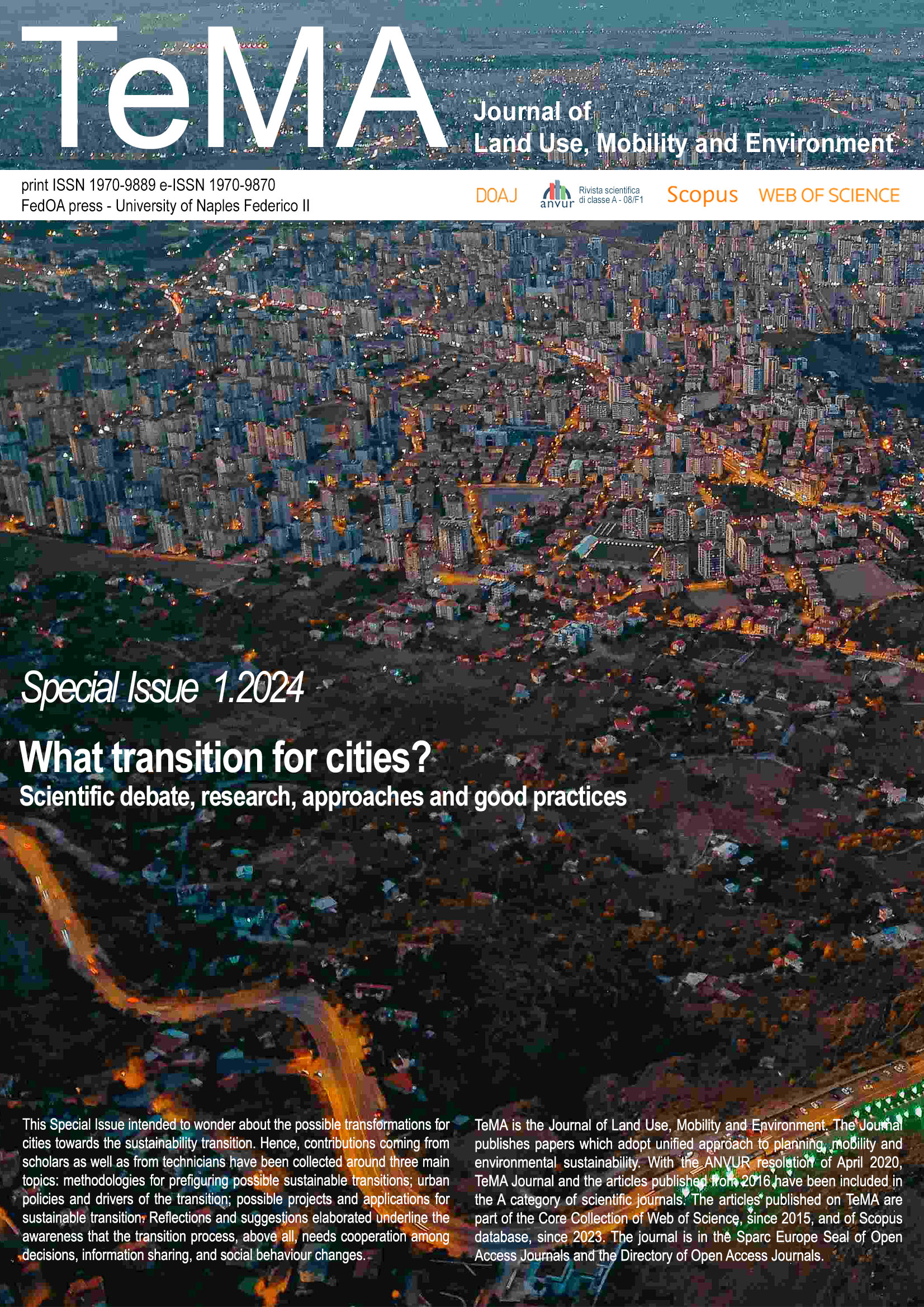 What transition for cities? Scientific debate, research, approaches and good practices
What transition for cities? Scientific debate, research, approaches and good practices
This Special Issue intended to wonder about what the possible transformation for cities towards the sustainability transition could be. Hence, contributions coming from scholars as well as from technicians have been collected around three main topics: methodologies for prefiguring possible sustainable transitions; urban policies and drivers of the transition; possible projects and applications for sustainable transition. Reflections and suggestions elaborated underline the awareness that transition process, above all, needs cooperation among decisions, information sharing, and social behaviors changes.
-
 The city challenges and external agents. Methods, tools and best practices
Vol 16 No 3 (2023)
The city challenges and external agents. Methods, tools and best practices
Vol 16 No 3 (2023)The challenge that the complexity of the ongoing phenomena imposes on cities involves not only adopting mitigation measures aimed at reducing the adverse effects of these phenomena; this challenge requires scholars, researchers, technicians, and decision makers to transform cities into resilient competitive urban systems rapidly. The three issues of the 16th volume collect articles concerning the climatic, social, economic and health phenomena that have increasingly affected our cities in recent years and, hence, require the identification and implementation of adaptation actions to improve the resilience of urban systems.
-
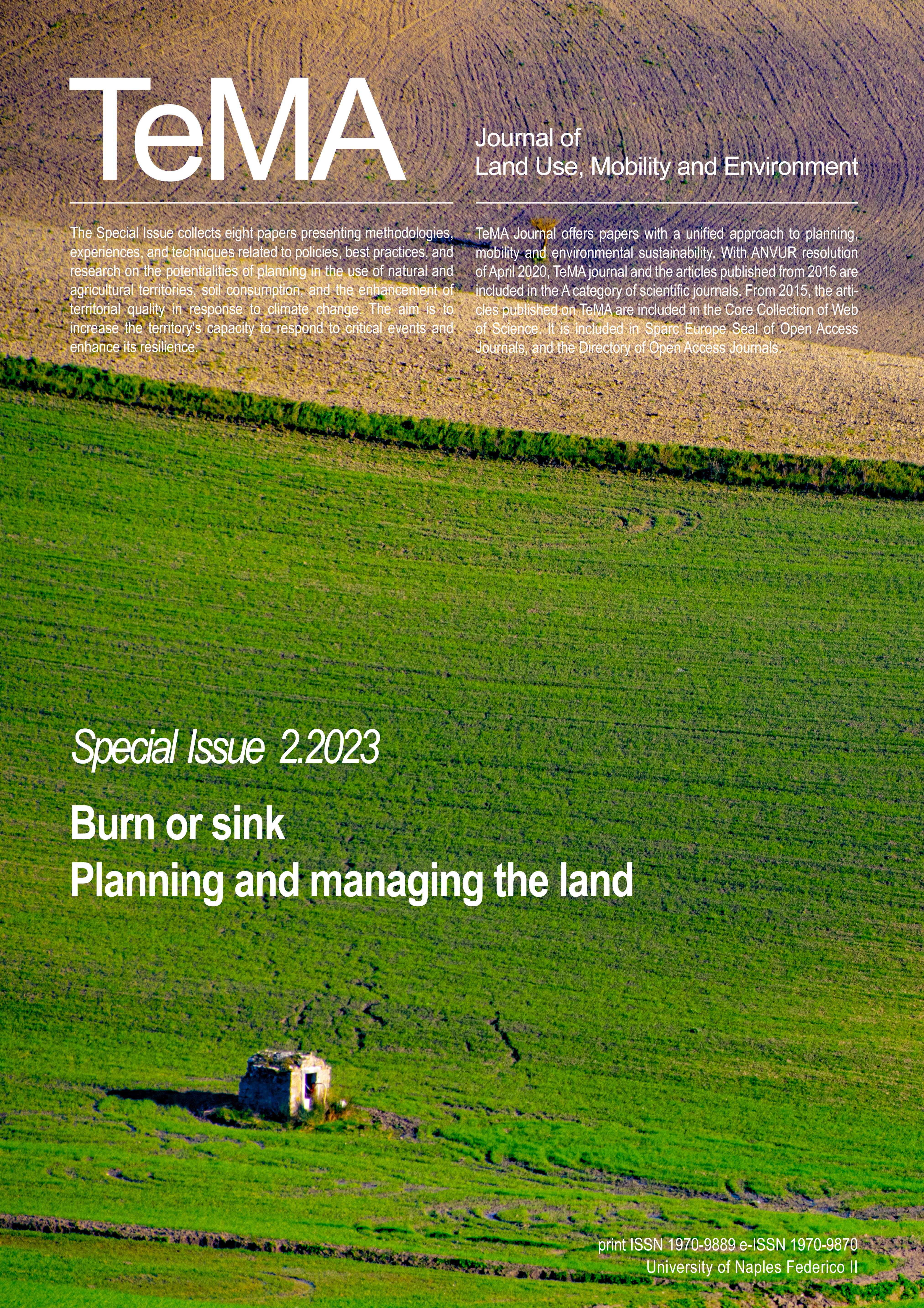 Burn or sink. Planning and managing the land
2023
Burn or sink. Planning and managing the land
2023The Special Issue collects eight papers presenting methodologies, experiences, and techniques related to policies, best practices, and research on the potentialities of planning in the use of natural and agricultural territories, soil consumption, and the enhancement of territorial quality in response to climate change. The aim is to increase the territory's capacity to respond to critical events and enhance its resilience.
-
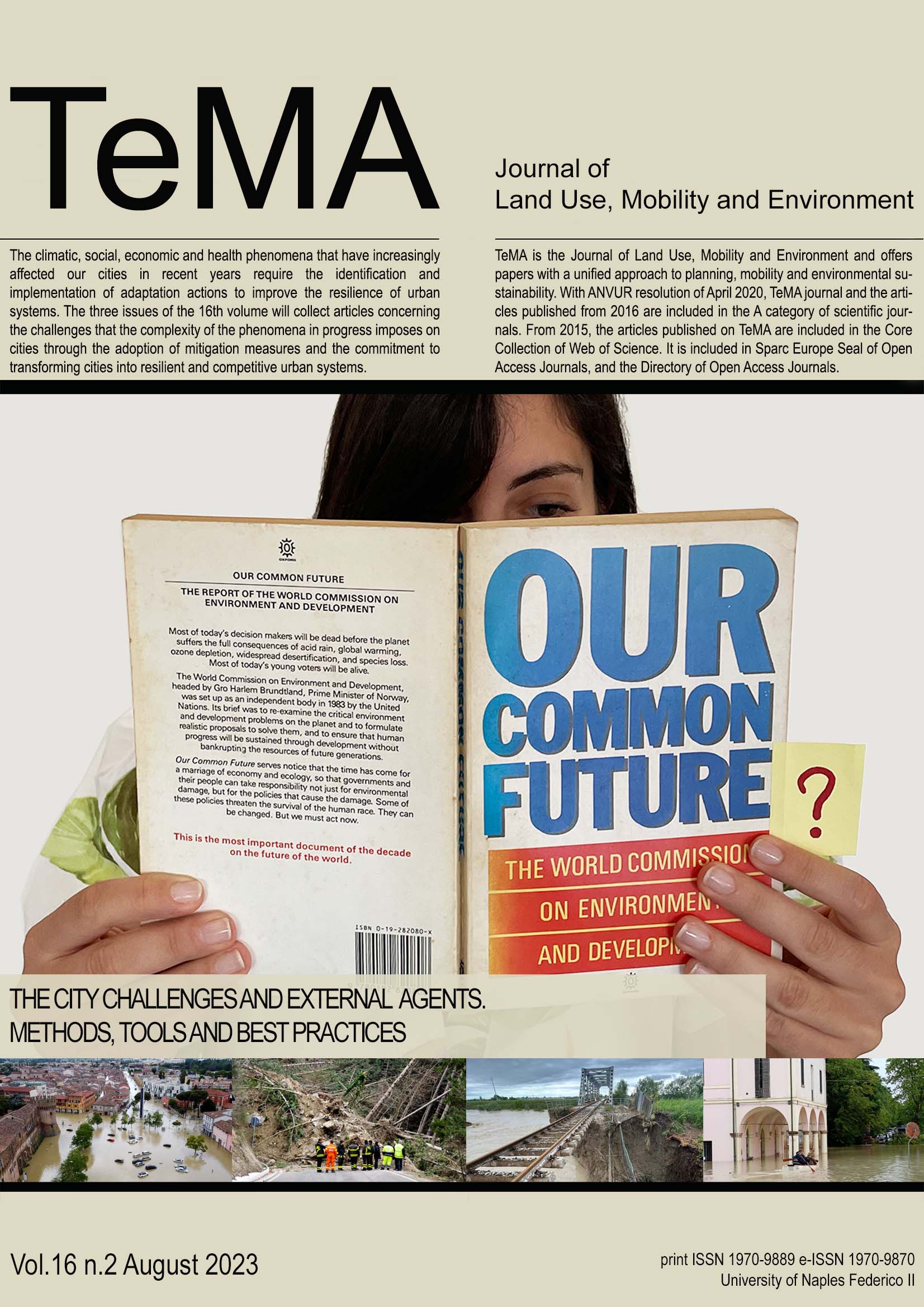 The city challenges and external agents. Methods, tools and best practices
Vol 16 No 2 (2023)
The city challenges and external agents. Methods, tools and best practices
Vol 16 No 2 (2023)The challenge that the complexity of the ongoing phenomena imposes on cities involves not only adopting mitigation measures aimed at reducing the adverse effects of these phenomena; this challenge requires scholars, researchers, technicians, and decision makers to transform cities into resilient competitive urban systems rapidly. The three issues of the 16th volume collect articles concerning the climatic, social, economic and health phenomena that have increasingly affected our cities in recent years and, hence, require the identification and implementation of adaptation actions to improve the resilience of urban systems.
-
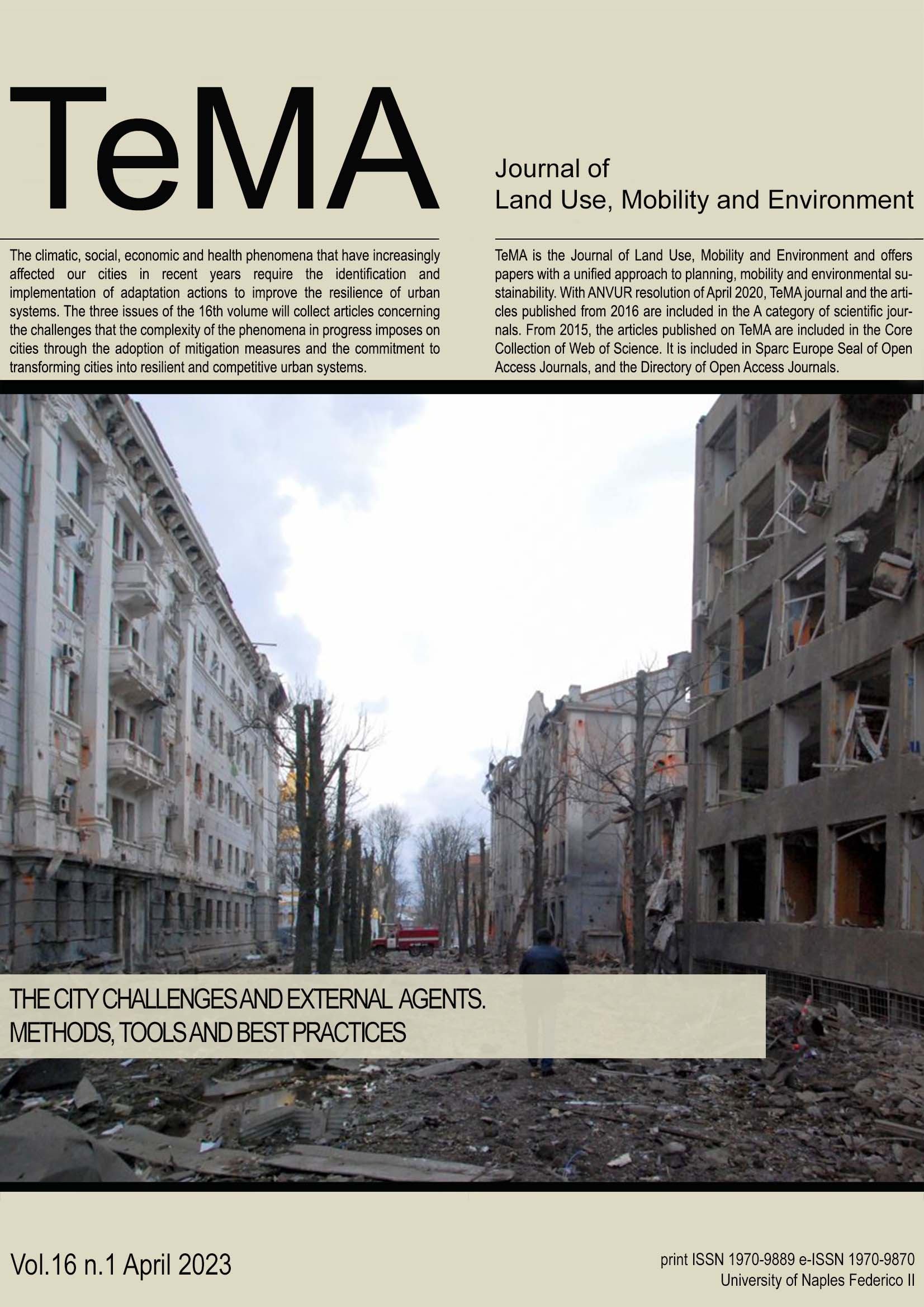 The city challenges and external agents. Methods, tools and best practices
Vol 16 No 1 (2023)
The city challenges and external agents. Methods, tools and best practices
Vol 16 No 1 (2023)The challenge that the complexity of the ongoing phenomena imposes on cities involves not only adopting mitigation measures aimed at reducing the adverse effects of these phenomena; this challenge requires scholars, researchers, technicians, and decision makers to transform cities into resilient competitive urban systems rapidly. The three issues of the 16th volume collect articles concerning the climatic, social, economic and health phenomena that have increasingly affected our cities in recent years and, hence, require the identification and implementation of adaptation actions to improve the resilience of urban systems.
-
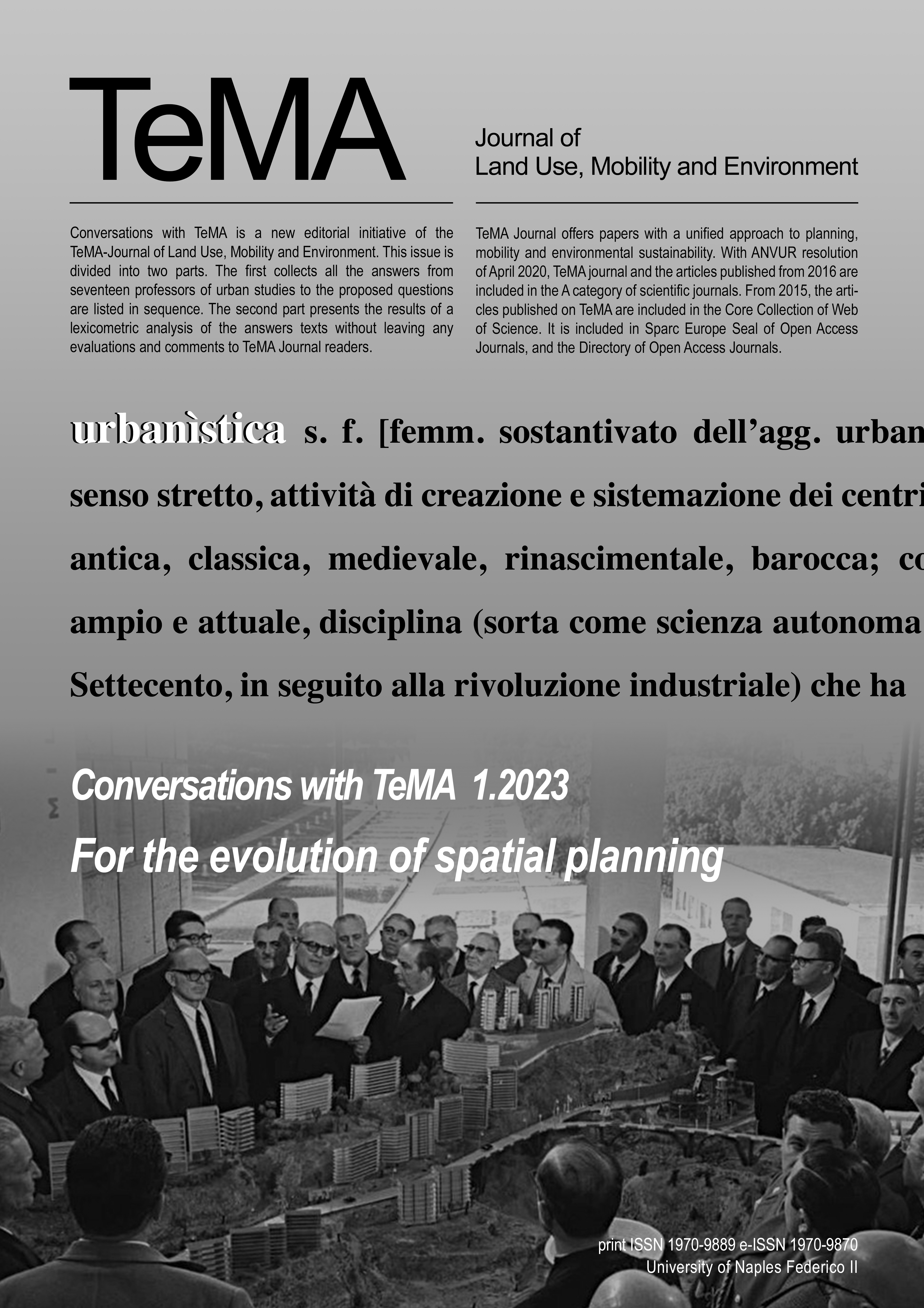 Conversations with TeMA. For the evolution of spatial planning
2023
Conversations with TeMA. For the evolution of spatial planning
2023Conversations with TeMA is a new editorial initiative of the TeMA-Journal of Land Use, Mobility and Environment. This issue is divided into two parts. The first collects all the answers from seventeen professors of urban studies to the proposed questions are listed in sequence. The second part presents the results of a lexicometric analysis of the answers texts without leaving any evaluations and comments to TeMA Journal readers.
-
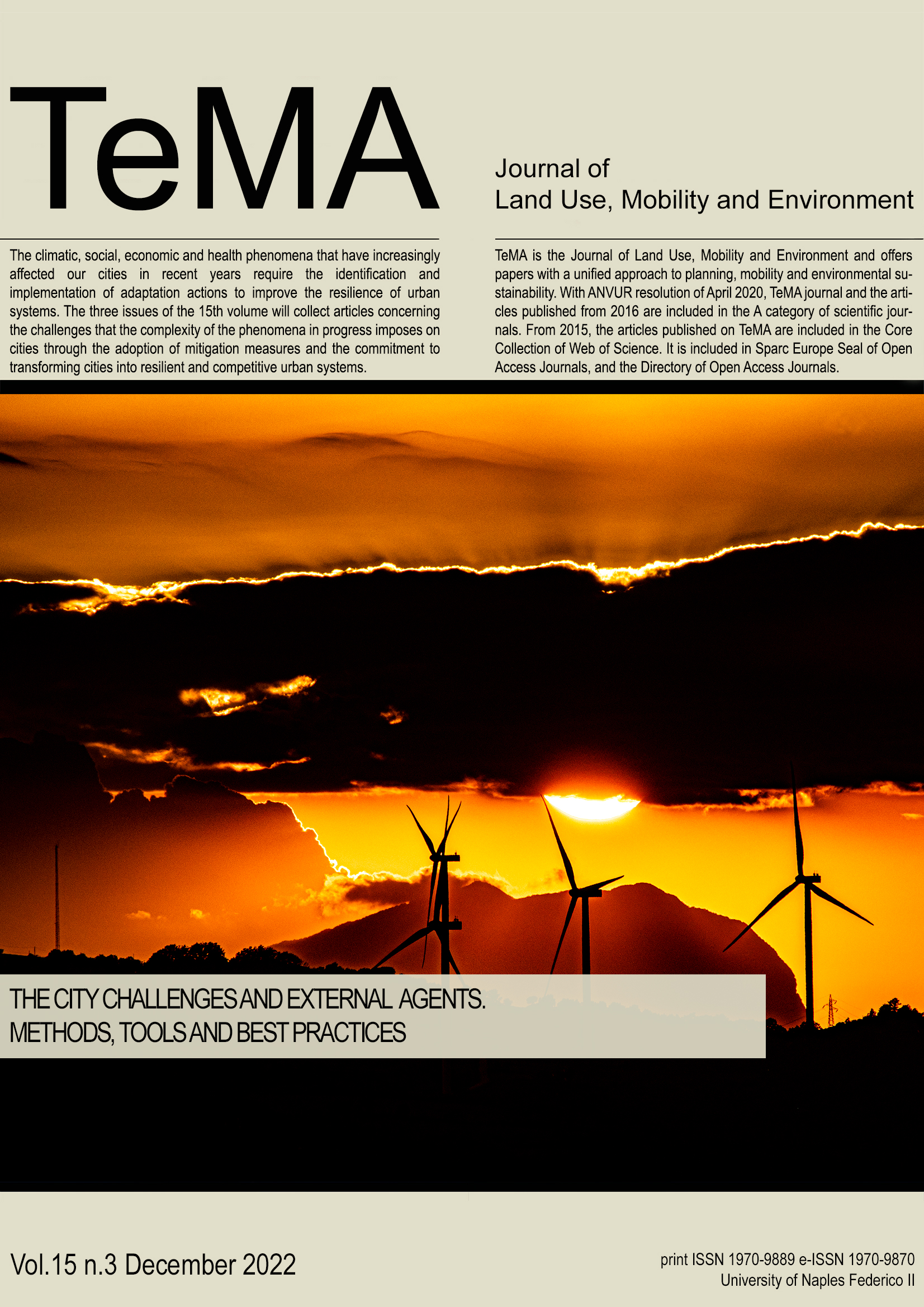 The city challenges and external agents. Methods, tools and best practices
Vol 15 No 3 (2022)
The city challenges and external agents. Methods, tools and best practices
Vol 15 No 3 (2022)The challenge that the complexity of the ongoing phenomena imposes on cities involves not only adopting mitigation measures aimed at reducing the adverse effects of these phenomena; this challenge requires scholars, researchers, technicians, and decision makers to transform cities into resilient competitive urban systems rapidly. The three issues of the 15th volume collect articles concerning the climatic, social, economic and health phenomena that have increasingly affected our cities in recent years and, hence, require the identification and implementation of adaptation actions to improve the resilience of urban systems.
-
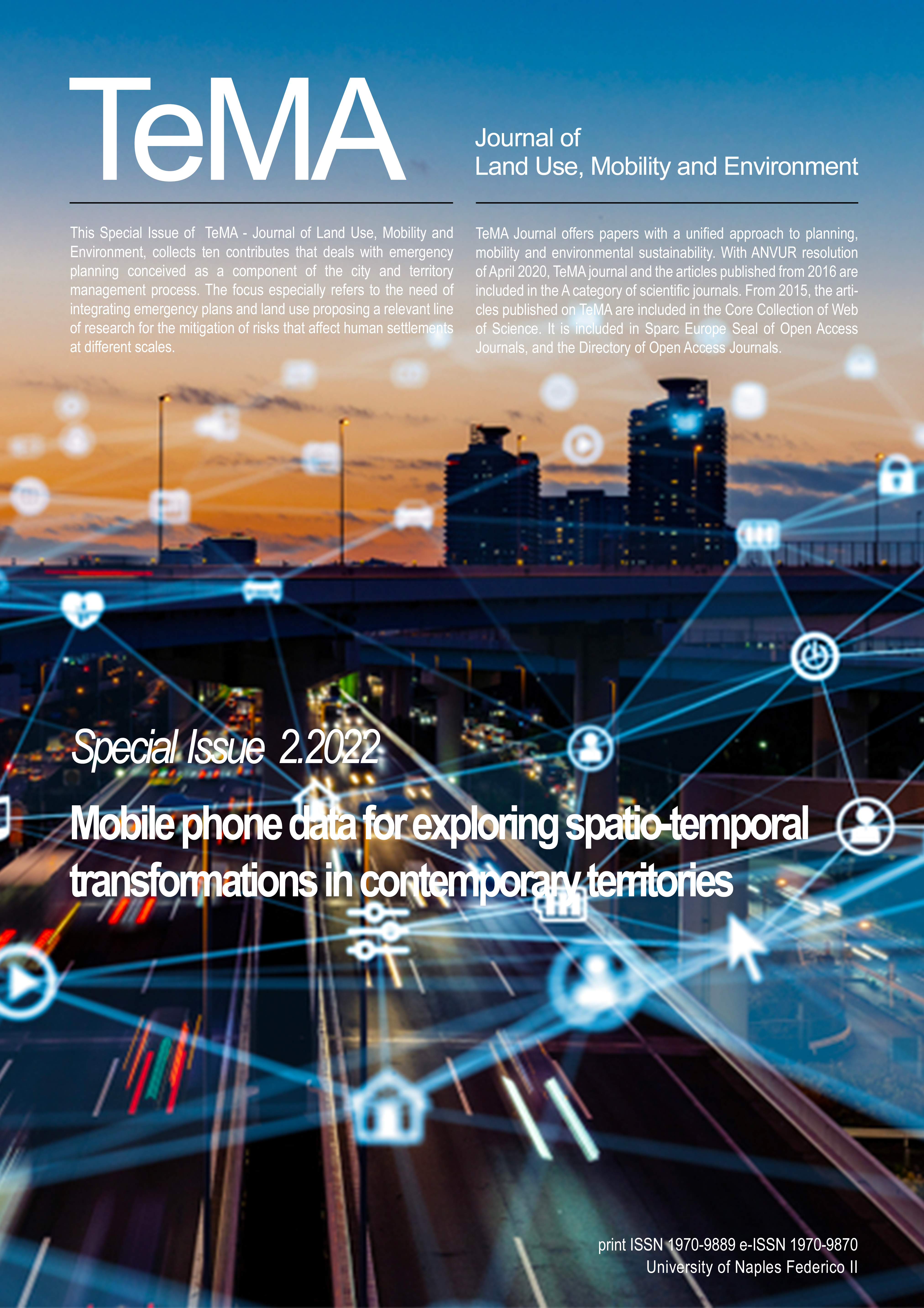 Special Issue. Mobile phone data for exploring spatio-temporal transformations in contemporary territories
2022
Special Issue. Mobile phone data for exploring spatio-temporal transformations in contemporary territories
2022The Special Issue collects six papers that use mobile phone data and spatial analysis techniques to study new urban critical features and social phenomena that arose with the Covid-19 pandemic. The applications of mobile phone data in the three study contexts investigated in this special issue highlight the potentialities of mobile phone data, as well as their limits. Compared to traditional methods of urban survey (such as census data or interviews), mobile phone data provide real-time maps of daily practices, thanks to valuable information on transient populations and their distribution over spaces.
-
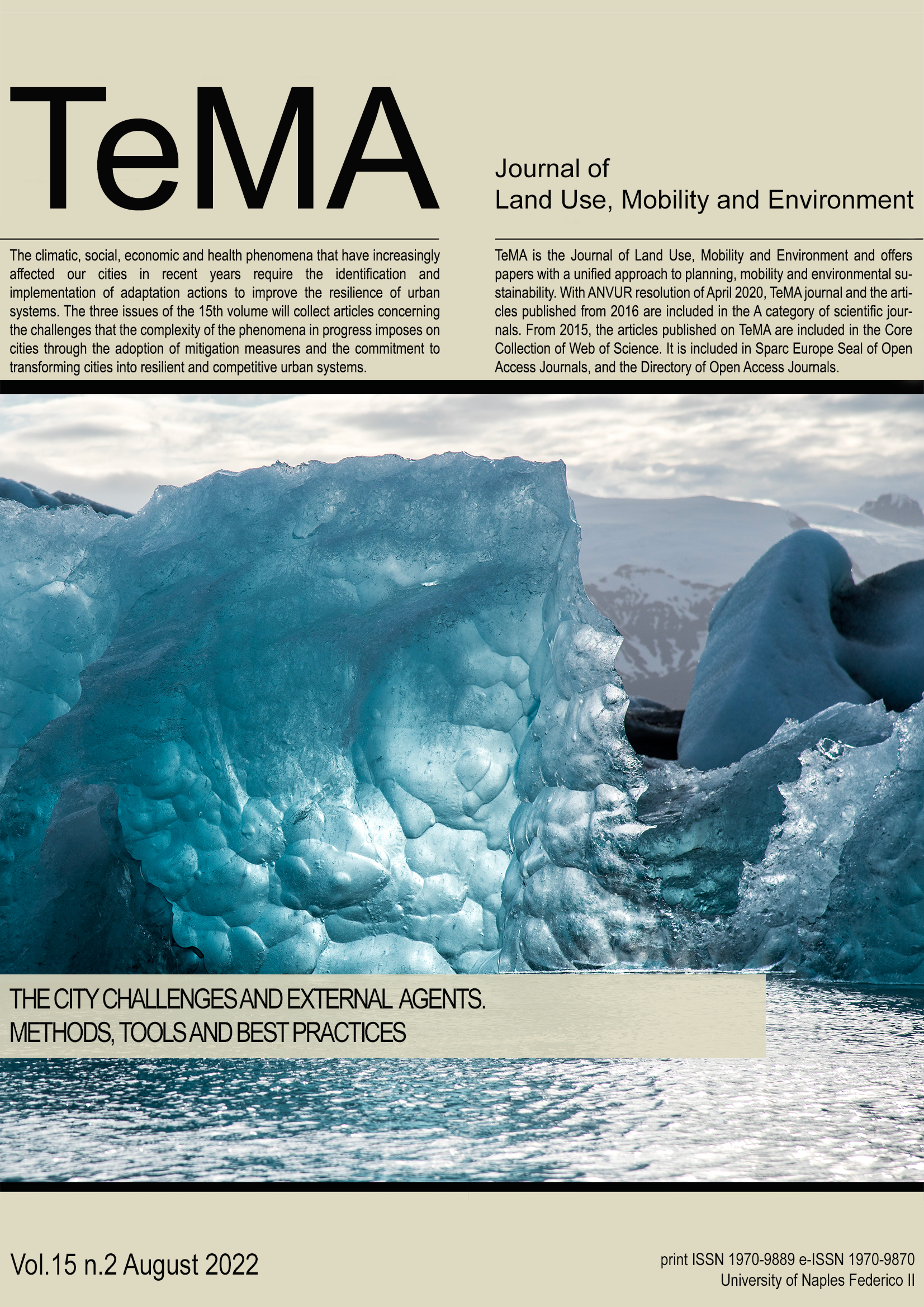 The city challenges and external agents. Methods, tools and best practices
Vol 15 No 2 (2022)
The city challenges and external agents. Methods, tools and best practices
Vol 15 No 2 (2022)The challenge that the complexity of the ongoing phenomena imposes on cities involves not only adopting mitigation measures aimed at reducing the adverse effects of these phenomena; this challenge requires scholars, researchers, technicians, and decision makers to transform cities into resilient competitive urban systems rapidly. The three issues of the 15th volume collect articles concerning the climatic, social, economic and health phenomena that have increasingly affected our cities in recent years and, hence, require the identification and implementation of adaptation actions to improve the resilience of urban systems.
-
 The city challenges and external agents. Methods, tools and best practices
Vol 15 No 1 (2022)
The city challenges and external agents. Methods, tools and best practices
Vol 15 No 1 (2022)The challenge that the complexity of the ongoing phenomena imposes on cities involves not only adopting mitigation measures aimed at reducing the adverse effects of these phenomena; this challenge requires scholars, researchers, technicians, and decision makers to transform cities into resilient competitive urban systems rapidly. The three issues of the 15th volume collect articles concerning the climatic, social, economic and health phenomena that have increasingly affected our cities in recent years and, hence, require the identification and implementation of adaptation actions to improve the resilience of urban systems.
-
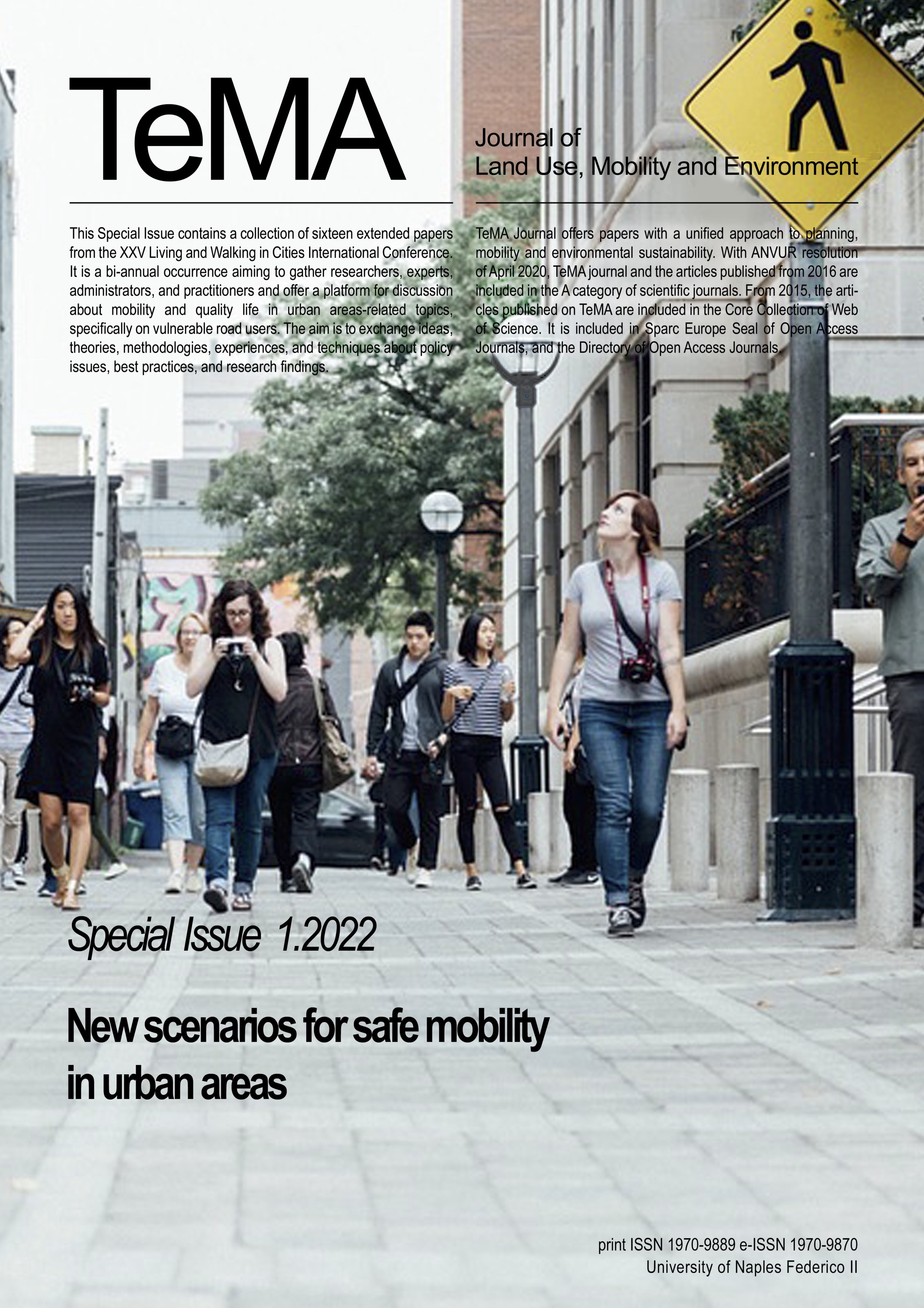 Special Issue. New Scenarios for Safe Mobility in Urban Areas
2022
Special Issue. New Scenarios for Safe Mobility in Urban Areas
2022This Special Issue contains a collection of sixteen extended papers from the XXV Living and Walking in Cities International Conference. It is a bi-annual conference aiming to gather researchers, experts, administrators, and practitioners and offer a platform for discussion about mobility and quality of life in urban areas, with a specific focus on vulnerable road users’ safety. The aim is to exchange ideas, theories, methodologies, experiences, and techniques about policy issues, best practices, and research findings.
-
 The city challenges and external agents. Methods, tools and best practices
Vol 14 No 3 (2021)
The city challenges and external agents. Methods, tools and best practices
Vol 14 No 3 (2021)Cities need to modify and/or adapt their urban form, the distribution and location of services and learn how to handle the increasing complexity to face the most pressing challenges of this century. The scientific community is working in order to minimise negative effects on the environment, social and economic issues and people’s health. The three issues of the 14th volume will collect articles concerning the topics addressed in 2020 and also the effects on the urban areas related to the spread Covid-19 pandemic.
-
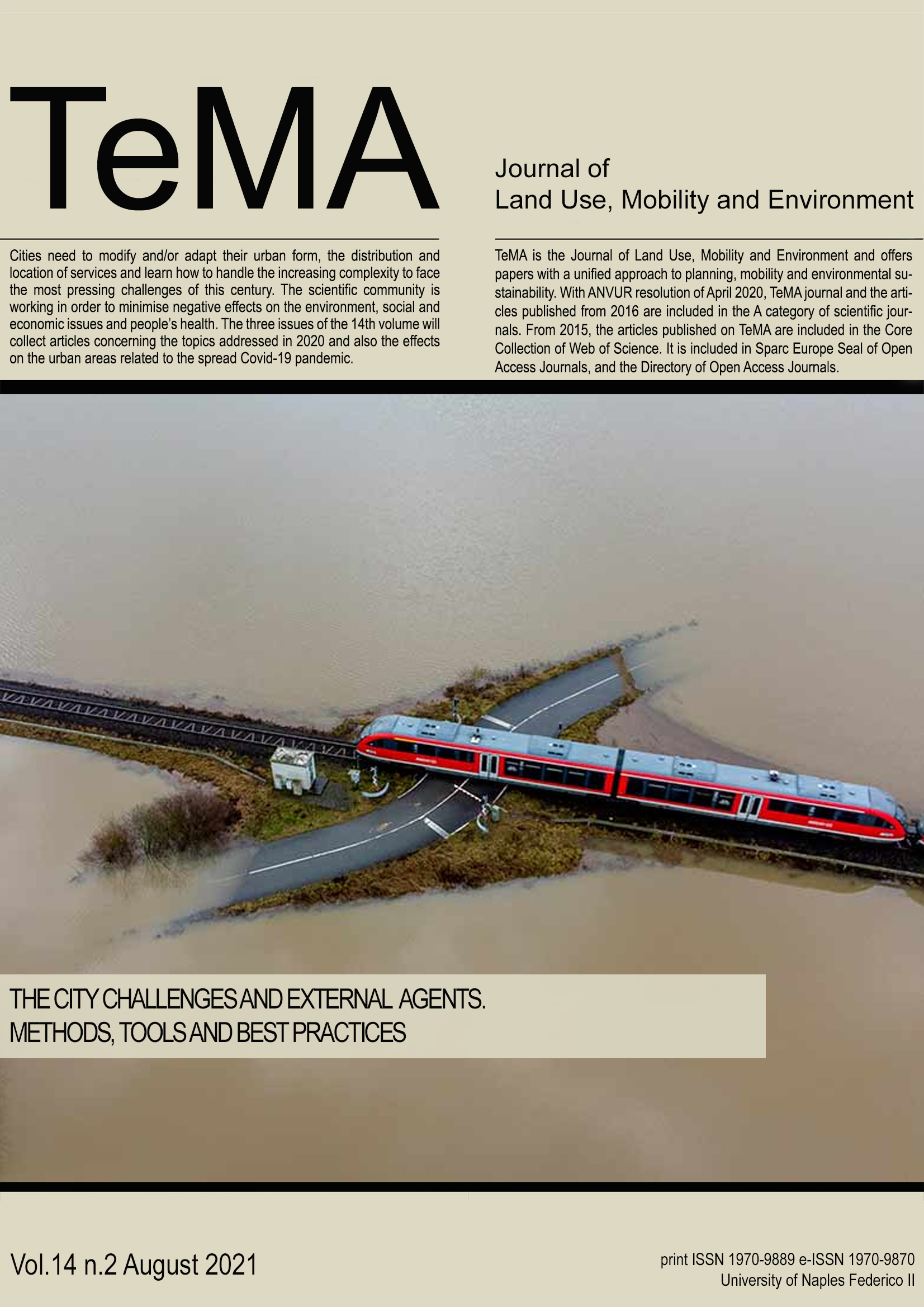 The city challenges and external agents. Methods, tools and best practices
Vol 14 No 2 (2121)
The city challenges and external agents. Methods, tools and best practices
Vol 14 No 2 (2121)Cities need to modify and/or adapt their urban form, the distribution and location of services and learn how to handle the increasing complexity to face the most pressing challenges of this century. The scientific community is working in order to minimise negative effects on the environment, social and economic issues and people’s health. The three issues of the 14th volume will collect articles concerning the topics addressed in 2020 and also the effects on the urban areas related to the spread Covid-19 pandemic.
-
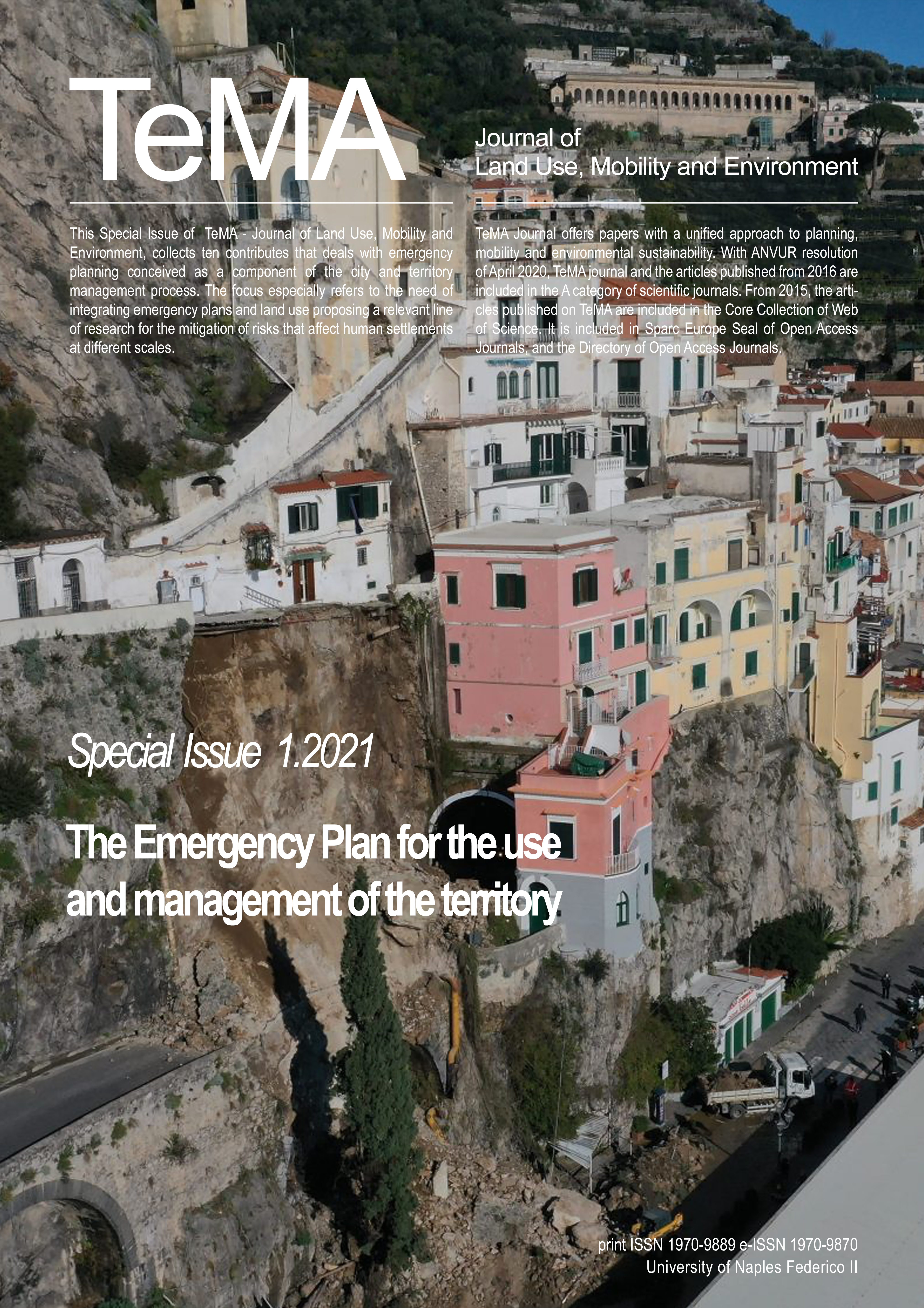 Special Issue. The emergency plan for the use and management of the territory
2021
Special Issue. The emergency plan for the use and management of the territory
2021This Special Issue of TeMA - Journal of Land Use, Mobility and Environment, collects eleven contributes that deals with emergency planning conceived as a component of the city and territory management process. The focus especially refers to the need of integrating emergency plans and land use proposing a relevant line of research for the mitigation of risks that affect human settlements at different scales.
-
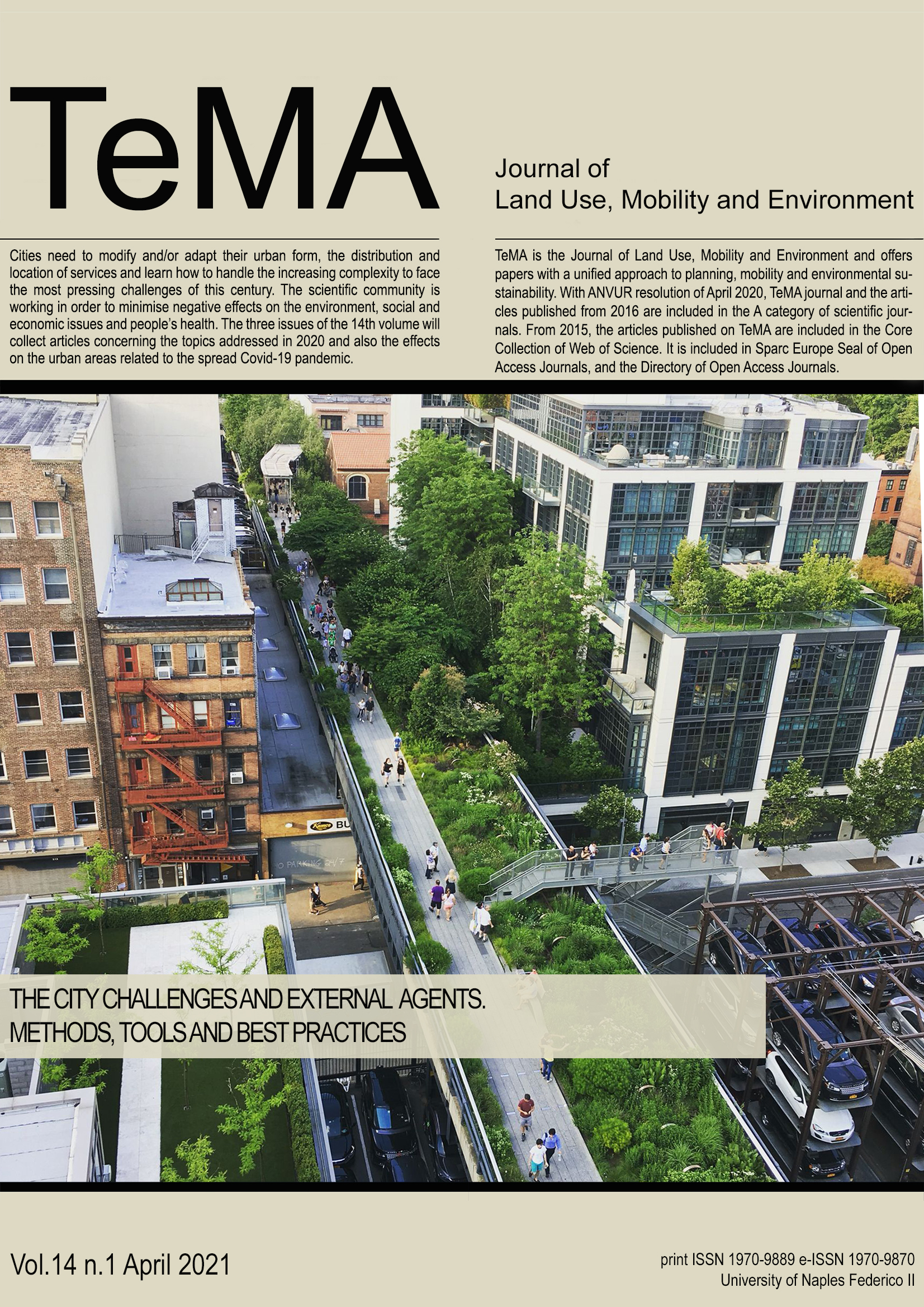 The city challenges and external agents. Methods, tools and best practices
Vol 14 No 1 (2021)
The city challenges and external agents. Methods, tools and best practices
Vol 14 No 1 (2021)Cities need to modify and/or adapt their urban form, the distribution and location of services and learn how to handle the increasing complexity to face the most pressing challenges of this century. The scientific community is working in order to minimise negative effects on the environment, social and economic issues and people’s health. The three issues of the 14th volume will collect articles concerning the topics addressed in 2020 and also the effects on the urban areas related to the spread Covid-19 pandemic.
-
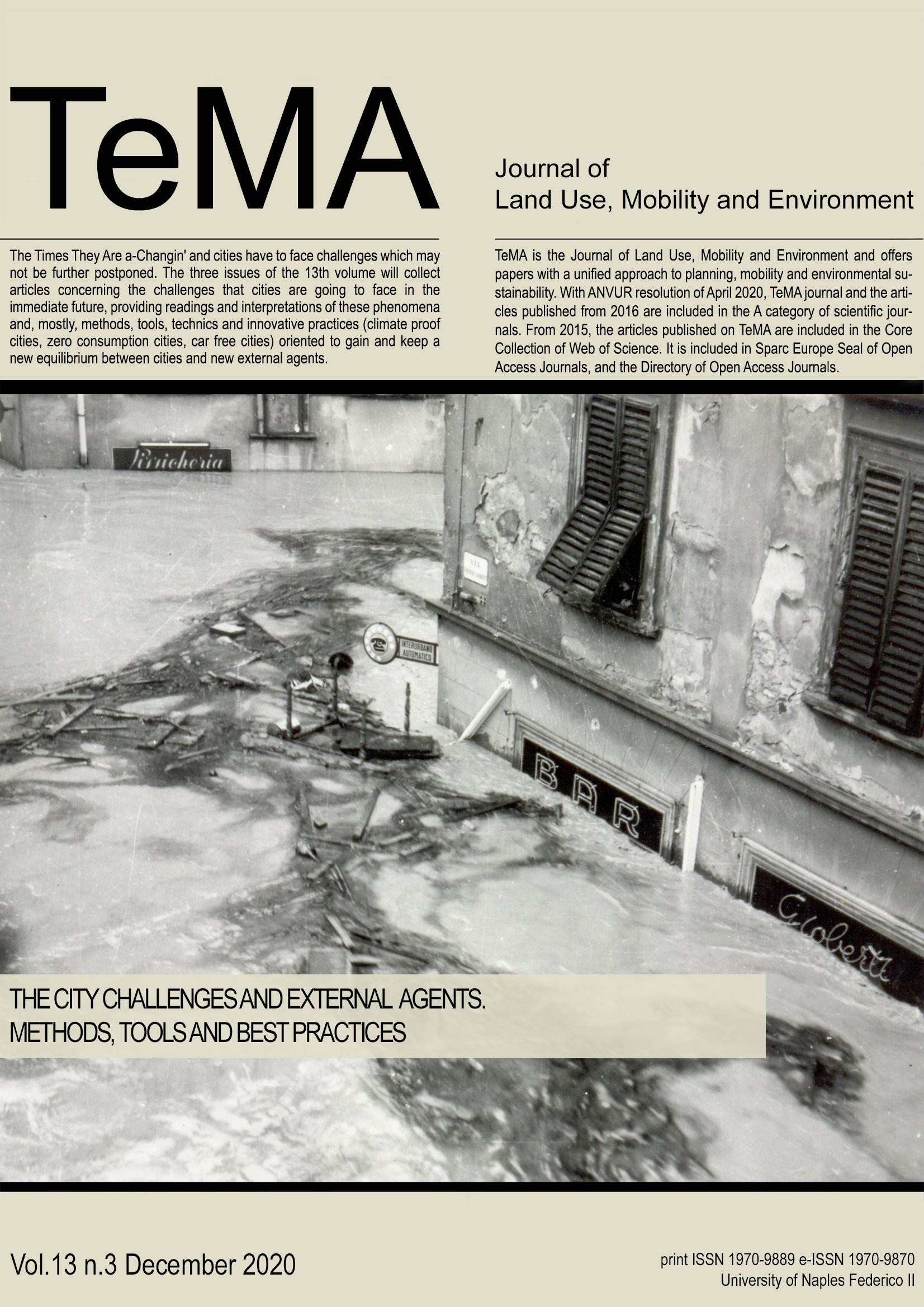 The city challenges and external agents. Methods, Tools and Best Practices
Vol 13 No 3 (2020)
The city challenges and external agents. Methods, Tools and Best Practices
Vol 13 No 3 (2020)The Times They Are a-Changin' and cities have to face challenges which may not be further postponed. In particular, six of these challenges to modify and/or adapt cities physical shape, facilities distribution and their organization as complex systems: climate changes effects, population aging, reduction of fossil-fuel energy consumptions, immigration flows from disadvantaged regions, technological innovation, and optimization of land use.
The three issues of the 13th volume will collect articles concerning the challenges that cities are going to face in the immediate future, providing readings and interpretations of these phenomena and, mostly, methods, tools, technics and innovative practices (defiantly defined as climate proof cities, zero consumption cities, car free cities, ...) oriented to gain and keep a new equilibrium between cities and new external agents. -
 The city challenges and external agents. Methods, Tools and Best Practices
Vol 13 No 2 (2020)
The city challenges and external agents. Methods, Tools and Best Practices
Vol 13 No 2 (2020)The Times They Are a-Changin' and cities have to face challenges which may not be further postponed. In particular, six of these challenges to modify and/or adapt cities physical shape, facilities distribution and their organization as complex systems: climate changes effects, population aging, reduction of fossil-fuel energy consumptions, immigration flows from disadvantaged regions, technological innovation, and optimization of land use.
The three issues of the 13th volume will collect articles concerning the challenges that cities are going to face in the immediate future, providing readings and interpretations of these phenomena and, mostly, methods, tools, technics and innovative practices (defiantly defined as climate proof cities, zero consumption cities, car free cities, ...) oriented to gain and keep a new equilibrium between cities and new external agents. -
 Special Issue. Covid-19 vs City-20
2020
Special Issue. Covid-19 vs City-20
2020This Special Issue of TeMA - Journal of Land Use, Mobility and Environment, collects twenty-seven contributes of international researchers and technicians in form of scenarios, insights, reasoning and research on the relations between the City and the impacts of Covid-19 pandemic, questioning about the development of a new vision and a general rethinking of the structure and urban organization.
-
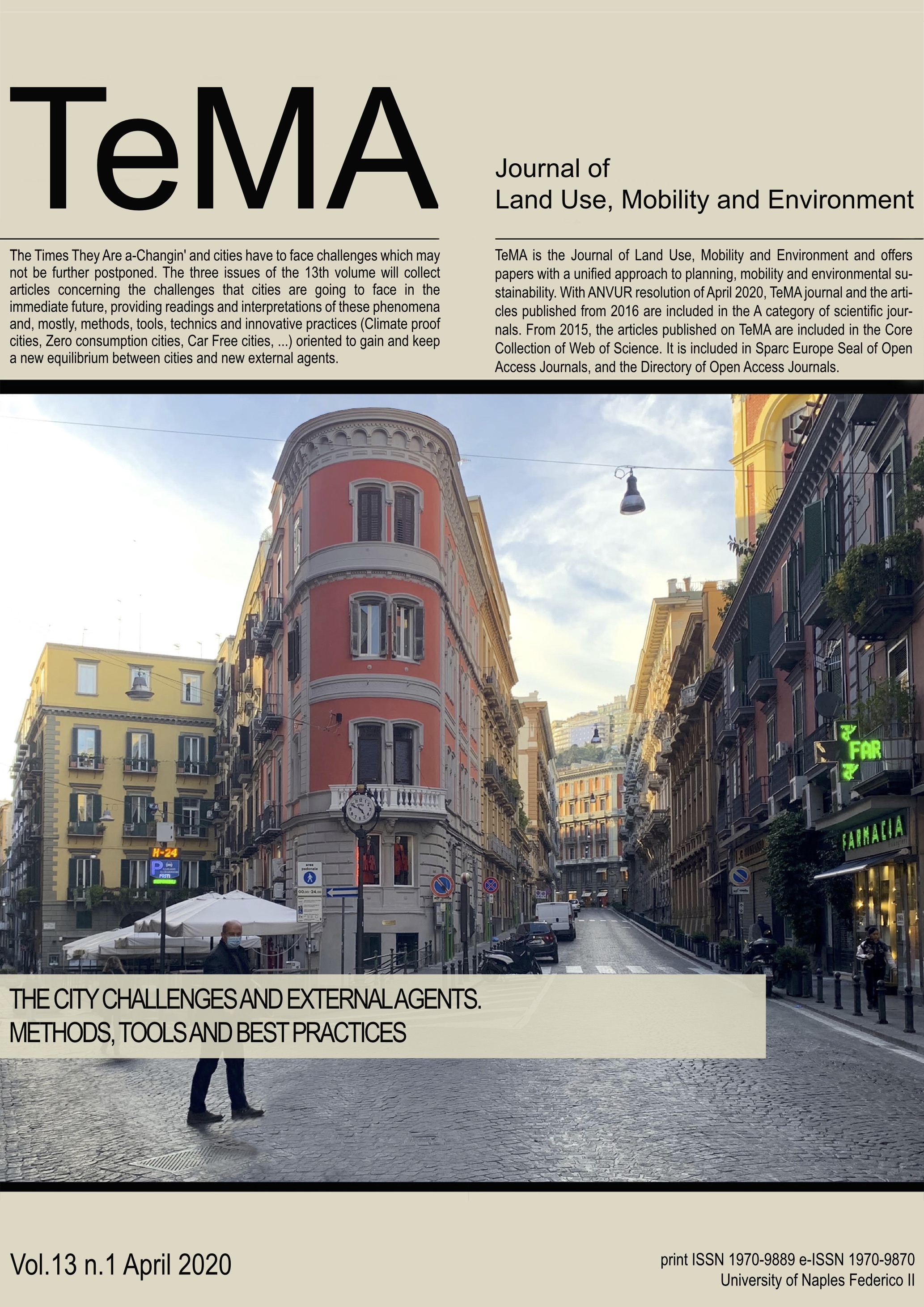 The city challenges and external agents. Methods, Tools and Best Practices
Vol 13 No 1 (2020)
The city challenges and external agents. Methods, Tools and Best Practices
Vol 13 No 1 (2020)The Times They Are a-Changin' and cities have to face challenges which may not be further postponed. In particular, six of these challenges to modify and/or adapt cities physical shape, facilities distribution and their organization as complex systems: climate changes effects, population aging, reduction of fossil-fuel energy consumptions, immigration flows from disadvantaged regions, technological innovation, and optimization of land use.
The three issues of the 13th volume will collect articles concerning the challenges that cities are going to face in the immediate future, providing readings and interpretations of these phenomena and, mostly, methods, tools, technics and innovative practices (defiantly defined as Climate proof cities, Zero consumption cities, Car Free cities, ..) oriented to gain and keep a new equilibrium between cities and new external agents. -
 The Times They Are a-Changin'
Vol 12 No 3 (2019)
The Times They Are a-Changin'
Vol 12 No 3 (2019)In these last ten years, TeMA Journal has published several international studies and researches supporting the scientific debate on the urban complexity and the future challenges of urban areas. Thus, the three issues of the 12th volume will think again about the debate on the definition and implementation of methods, tools and best practices connected to the evolution of the main scientific topics examined in depth in previous TeMA Journal volumes. In detail, the Journal welcomes papers on topics about the interdisciplinary interaction among Land Use, Mobility and Environment, and also urban studies from the domains of engineering, planning, modelling, behaviour, regional economics, geography, regional science, architecture and design, network science, complex systems, energy efficiency, urban accessibility, resilience and adaptation.
-
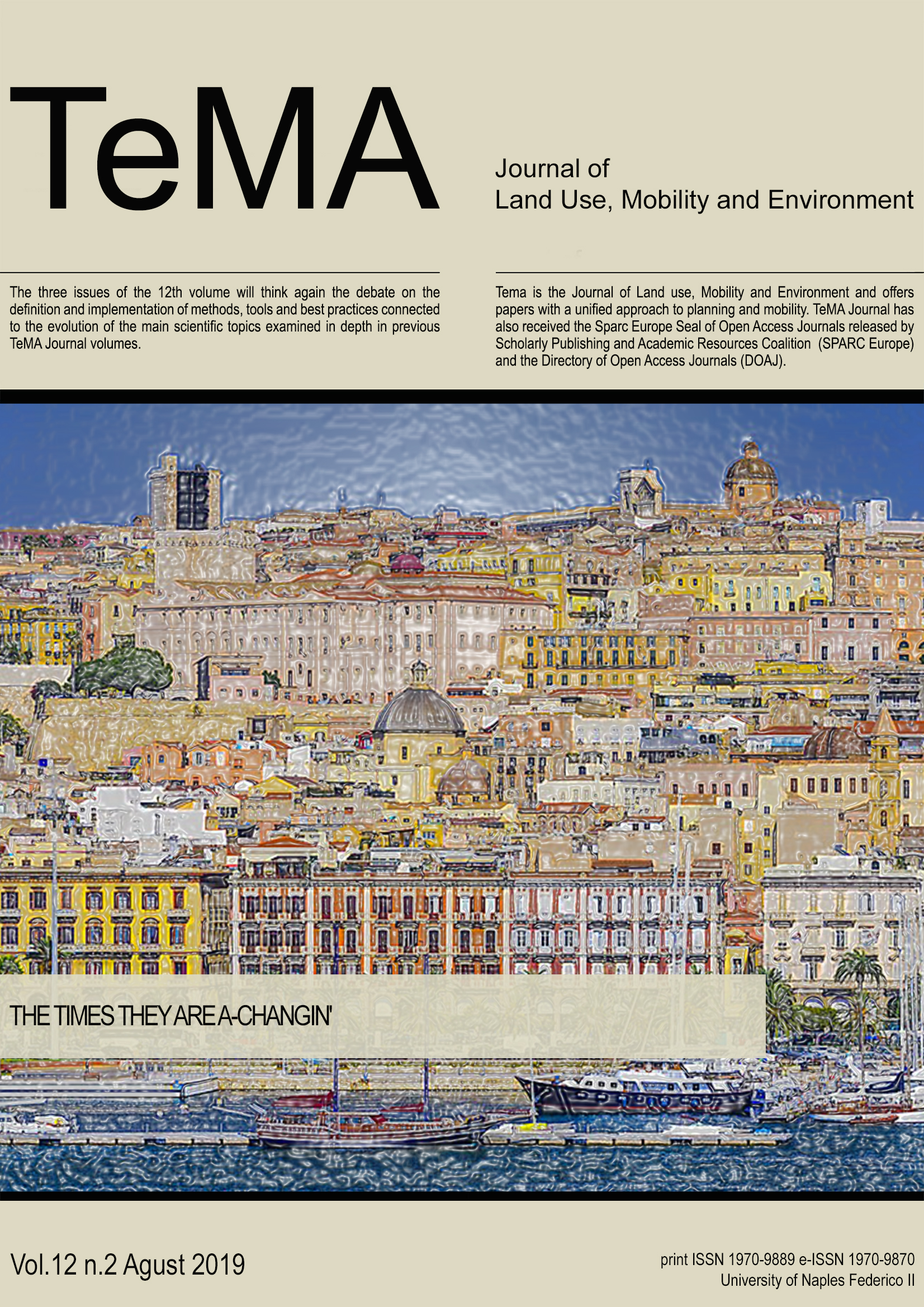 The Times They Are a-Changin'
Vol 12 No 2 (2019)
The Times They Are a-Changin'
Vol 12 No 2 (2019)In these last ten years, TeMA Journal has published several international studies and researches supporting the scientific debate on the urban complexity and the future challenges of urban areas. Thus, the three issues of the 12th volume will think again about the debate on the definition and implementation of methods, tools and best practices connected to the evolution of the main scientific topics examined in depth in previous TeMA Journal volumes. In detail, the Journal welcomes papers on topics about the interdisciplinary interaction among Land Use, Mobility and Environment, and also urban studies from the domains of engineering, planning, modelling, behaviour, regional economics, geography, regional science, architecture and design, network science, complex systems, energy efficiency, urban accessibility, resilience and adaptation.
-
 The Times They Are a-Changin'
Vol 12 No 1 (2019)
The Times They Are a-Changin'
Vol 12 No 1 (2019)In these last ten years, TeMA Journal has published several international studies and researches supporting the scientific debate on the urban complexity and the future challenges of urban areas. Thus, the three issues of the 12th volume will think again about the debate on the definition and implementation of methods, tools and best practices connected to the evolution of the main scientific topics examined in depth in previous TeMA Journal volumes. In detail, the Journal welcomes papers on topics about the interdisciplinary interaction among Land Use, Mobility and Environment, and also urban studies from the domains of engineering, planning, modelling, behaviour, regional economics, geography, regional science, architecture and design, network science, complex systems, energy efficiency, urban accessibility, resilience and adaptation.
-
 The Resilience City/The Fragile City. Methods, tools and best practices
Vol 11 No 3 (2018)
The Resilience City/The Fragile City. Methods, tools and best practices
Vol 11 No 3 (2018)The fragile/resilience city represents a topic that collects itself all the issues related to the urban risks and referred to the different impacts that an urban system has to face with. Studies useful to improve the urban conditions of resilience (physical, environmental, economical, social) are particularly welcome. Main topics to consider could be issues of water, soil, energy, etc.. The identification of urban fragilities could represent a new first step in order to develop and to propose methodological and operative innovations for the planning and the management of the urban and territorial transformations.
-
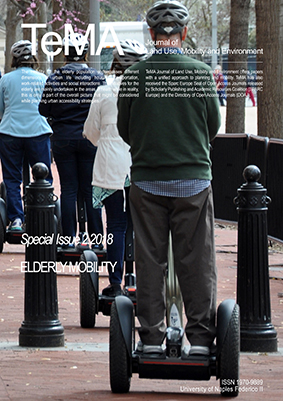 Special Issue 2.2018. Elderly Mobility
2018
Special Issue 2.2018. Elderly Mobility
2018This Special Issue of TeMA Journal of Land Use, Mobility and Environment collects the research works of one of the sessions organised in the framework of the XX Scientific Meeting of the Società Italiana degli Economisti dei Trasporti e della Logistica (SIET), focused on the MOBILAGE (Mobility and aging: daily life and welfare supportive networks at the neighbourhood level) research project financed by Fondazione Cariplo within the “Aging and social research: people, places and relations” 2017 Call for scientific research. The session was addressed to investigate elderly (people aged 65+) mobility, by exploring the supply and demand of Local Public Transport (LPT) in urban areas.
-
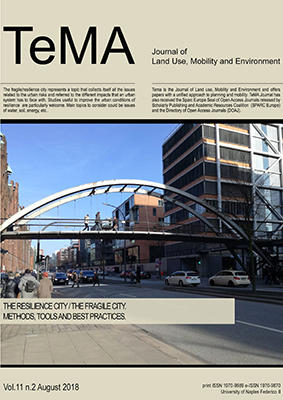 The Resilience City/The Fragile City. Methods, tools and best practices
Vol 11 No 2 (2018)
The Resilience City/The Fragile City. Methods, tools and best practices
Vol 11 No 2 (2018)The fragile/resilience city represents a topic that collects itself all the issues related to the urban risks and referred to the different impacts that an urban system has to face with. Studies useful to improve the urban conditions of resilience (physical, environmental, economical, social) are particularly welcome. Main topics to consider could be issues of water, soil, energy, etc.. The identification of urban fragilities could represent a new first step in order to develop and to propose methodological and operative innovations for the planning and the management of the urban and territorial transformations.
-
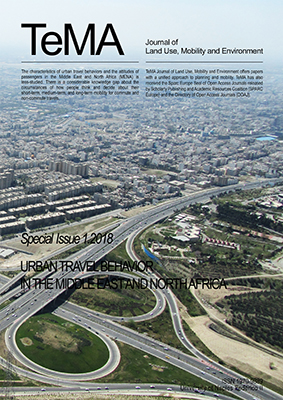 Special Issue 1.2018. Urban Travel Behavior in the Middle East and North Africa
2018
Special Issue 1.2018. Urban Travel Behavior in the Middle East and North Africa
2018The characteristics of urban travel behaviors and the attitudes of passengers in the Middle East and North Africa (MENA) is less-studied. When it comes to the effects of urban form, residential self-selections, and lifestyles, it is entirely not investigated in majority of the countries of the region. There is a considerable knowledge gap about the circumstances of how people think and decide about their short-term, medium-term, and long-term mobility for commute and non-commute travels. The we do not know if the land use traits such as population and employment densities as well as mix of land uses, accessibility to public transportation and neighborhood amenities, and connectivity of street networks are as influential as they are in western counties or in higher income societies. There is a very limited understanding about the extent to which the personal preferences, lifestyles, and in general psychology of the people of the region affect their transport behaviors. The complexity of the analysis methods applied for studying urban travel phenomena of the MENA region is even less-developed. Longitudinal or discrete choice molding methods are applied in mobility research considerably less than studies coming from high-income countries.
-
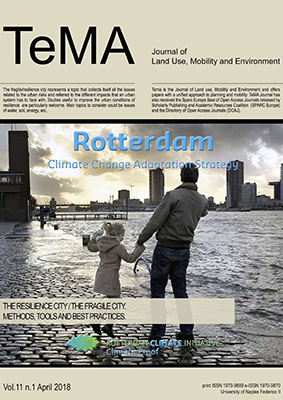 The Resilience City/The Fragile City. Methods, tools and best practices
Vol 11 No 1 (2018)
The Resilience City/The Fragile City. Methods, tools and best practices
Vol 11 No 1 (2018)The fragile/resilience city represents a topic that collects itself all the issues related to the urban risks and referred to the different impacts that an urban system has to face with. Studies useful to improve the urban conditions of resilience (physical, environmental, economical, social) are particularly welcome. Main topics to consider could be issues of water, soil, energy, etc.. The identification of urban fragilities could represent a new first step in order to develop and to propose methodological and operative innovations for the planning and the management of the urban and territorial transformations.
-
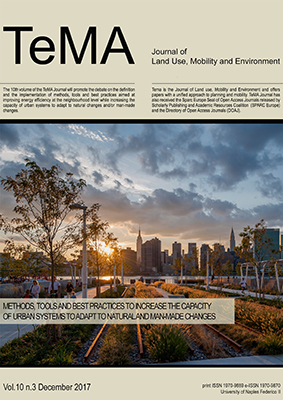 Methods, tools and best practices to increase the capacity of urban systems to adapt to natural and man-made changes
Vol 10 No 3 (2017)The 10th volume of the TeMA Journal will promote the debate on the definition and the implementation of methods, tools and best practices aimed at improving energy efficiency (e.g. green and blue infrastructures) at the neighbourhood level while increasing the capacity (i.e. resilience) of urban systems to adapt to natural changes (e.g. climate change) and/or man-made changes (e.g. migration flow, land take, tourism, suburban areas degradation, free car areas).
Methods, tools and best practices to increase the capacity of urban systems to adapt to natural and man-made changes
Vol 10 No 3 (2017)The 10th volume of the TeMA Journal will promote the debate on the definition and the implementation of methods, tools and best practices aimed at improving energy efficiency (e.g. green and blue infrastructures) at the neighbourhood level while increasing the capacity (i.e. resilience) of urban systems to adapt to natural changes (e.g. climate change) and/or man-made changes (e.g. migration flow, land take, tourism, suburban areas degradation, free car areas). -
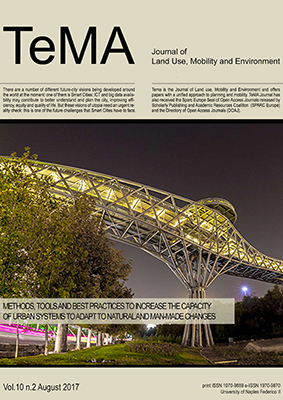 Methods, tools and best practices to increase the capacity of urban systems to adapt to natural and man-made changes
Vol 10 No 2 (2017)The 10th volume of the TeMA Journal will promote the debate on the definition and the implementation of methods, tools and best practices aimed at improving energy efficiency (e.g. green and blue infrastructures) at the neighbourhood level while increasing the capacity (i.e. resilience) of urban systems to adapt to natural changes (e.g. climate change) and/or man-made changes (e.g. migration flow, land take, tourism, suburban areas degradation, free car areas).
Methods, tools and best practices to increase the capacity of urban systems to adapt to natural and man-made changes
Vol 10 No 2 (2017)The 10th volume of the TeMA Journal will promote the debate on the definition and the implementation of methods, tools and best practices aimed at improving energy efficiency (e.g. green and blue infrastructures) at the neighbourhood level while increasing the capacity (i.e. resilience) of urban systems to adapt to natural changes (e.g. climate change) and/or man-made changes (e.g. migration flow, land take, tourism, suburban areas degradation, free car areas). -
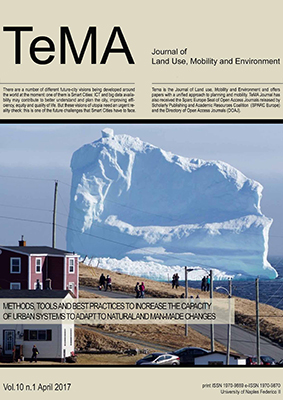 Methods, tools and best practices to increase the capacity of urban systems to adapt to natural and man-made changes
Vol 10 No 1 (2017)The 10th volume of the TeMA Journal will promote the debate on the definition and the implementation of methods, tools and best practices aimed at improving energy efficiency (e.g. green and blue infrastructures) at the neighbourhood level while increasing the capacity (i.e. resilience) of urban systems to adapt to natural changes (e.g. climate change) and/or man-made changes (e.g. migration flow, land take, tourism, suburban areas degradation, free car areas).
Methods, tools and best practices to increase the capacity of urban systems to adapt to natural and man-made changes
Vol 10 No 1 (2017)The 10th volume of the TeMA Journal will promote the debate on the definition and the implementation of methods, tools and best practices aimed at improving energy efficiency (e.g. green and blue infrastructures) at the neighbourhood level while increasing the capacity (i.e. resilience) of urban systems to adapt to natural changes (e.g. climate change) and/or man-made changes (e.g. migration flow, land take, tourism, suburban areas degradation, free car areas). -
 Planning for livable and safe cities: Socio-economic changes in advanced societies
Vol 9 No 3 (2016)Contributions dealing with strategies and measures aimed at reducing the impacts of socio-economic dynamics on cities life and organization by redefining the physical and functional form of the urban environment are invited. In particular, contributions dealing with population aging, globalization and migration flows are especially welcome. Specific attention will be devoted to the development and pervasiveness of new communication technologies as a tool to design innovative techniques of governance and management of the urban development, which are appropriate to the increasing complexity of urban systems and able to promote a wider participation in the decision making processes as well as guide the implementation of the foreseen strategies and the monitoring of the urban systems’ development.
Planning for livable and safe cities: Socio-economic changes in advanced societies
Vol 9 No 3 (2016)Contributions dealing with strategies and measures aimed at reducing the impacts of socio-economic dynamics on cities life and organization by redefining the physical and functional form of the urban environment are invited. In particular, contributions dealing with population aging, globalization and migration flows are especially welcome. Specific attention will be devoted to the development and pervasiveness of new communication technologies as a tool to design innovative techniques of governance and management of the urban development, which are appropriate to the increasing complexity of urban systems and able to promote a wider participation in the decision making processes as well as guide the implementation of the foreseen strategies and the monitoring of the urban systems’ development. -
 Special Issue 1.2016. Transit-Oriented Development in Iran: Challenges and Solutions
2016
Special Issue 1.2016. Transit-Oriented Development in Iran: Challenges and Solutions
2016The Special Issue the Tema Journal of Land Use, Mobility and Environment, collects the proceedings of the Joint workshop, which is to be held by Center for Technology of Society (ZTG) of Technische Universität Berlin (TUB) and Road, Housing and Urban Development Research Center (BHRC) in Tehran on Feb. 29, 2016, under the title “Transit-Oriented Development (TOD) in Iran: Challenges and Solutions”. Although the contents of the workshop target TOD in Iran, it has a partial look to the experiences of Germany. Identifying the problems that have limited the positive effects, user-friendliness, and good accessibility of public transport systems in Iran, as well as putting the state of the art of the topic practiced in Germany into discussion with Iranian experts are the most prominent targets of the workshop. Topics on the borderline between urban transportation planning, urban planning, and urban design need to be addressed in the dialogue facilitated between the Iranian and German experts.
-
 Planning for livable and safe cities: Energy, pollution and the degradation of the urban environment
Vol 9 No 2 (2016)Strategies and measures aimed at reducing the main sources of pollution/energy consumption/degradation of the urban environment while improving the quality of life in cities are invited. In particular, contributions dealing with residential energy consumption, transport energy consumption and noise pollution are especially welcome. Specific attention will be devoted to the development and pervasiveness of new communication technologies as a tool to design innovative techniques of governance and management of the urban development, which are appropriate to the increasing complexity of urban systems and able to promote a wider participation in the decision making processes as well as guide the implementation of the foreseen strategies and the monitoring of the urban systems’ development.
Planning for livable and safe cities: Energy, pollution and the degradation of the urban environment
Vol 9 No 2 (2016)Strategies and measures aimed at reducing the main sources of pollution/energy consumption/degradation of the urban environment while improving the quality of life in cities are invited. In particular, contributions dealing with residential energy consumption, transport energy consumption and noise pollution are especially welcome. Specific attention will be devoted to the development and pervasiveness of new communication technologies as a tool to design innovative techniques of governance and management of the urban development, which are appropriate to the increasing complexity of urban systems and able to promote a wider participation in the decision making processes as well as guide the implementation of the foreseen strategies and the monitoring of the urban systems’ development. -
 Planning for livable and safe cities: Extreme weather events caused by climate change
Vol 9 No 1 (2016)
Planning for livable and safe cities: Extreme weather events caused by climate change
Vol 9 No 1 (2016)Strategies and measures aimed at reducing the vulnerability of existing urban settlements to climate-related phenomena focusing on measures/strategies both in the urban planning and the building design sector as well as in the legislative/normative one. Specific attention has been given to new communication technologies as a tool to design innovative techniques of governance and management of the urban development, which are appropriate to the increasing complexity of urban systems and able to promote a wider participation in the decision making processes as well as guide the implementation of the foreseen strategies and the monitoring of the urban systems’ development.
-
 Cities, Energy and Mobility Strategies for consumptions’ reduction
Vol 8 No 3 (2015)Transport energy consumption accounts for about one third of total energy consumption in the EU. Despite significant advances in transport technology, energy consumption in this sector has increased in most EU countries over the last three decades. Long-term forecast to 2030 suggest that energy consumption will further increase in all major sectors, experiencing the most rapid growth in the transport sector. This issue of TeMA is focused on methods, techniques and tools related to urban and regional mobility considered in a key dimension of energy saving.
Cities, Energy and Mobility Strategies for consumptions’ reduction
Vol 8 No 3 (2015)Transport energy consumption accounts for about one third of total energy consumption in the EU. Despite significant advances in transport technology, energy consumption in this sector has increased in most EU countries over the last three decades. Long-term forecast to 2030 suggest that energy consumption will further increase in all major sectors, experiencing the most rapid growth in the transport sector. This issue of TeMA is focused on methods, techniques and tools related to urban and regional mobility considered in a key dimension of energy saving. -
 ECCA 2015 - Smart and Resilient Cities. Ideas and Practices from the South of Europe
2015The Special Issue the Tema Journal of Land Use, Mobility and Environment, collects the proceedings of one of the Sessions framed into the second European Conference on Climate Adaptation (ECCA 2015) held in Copenhagen in May 2015 and promoted, among the others, by the EU Commission, the City of Copenhagen, The European Environment Agency, beside some European research projects (BASE, RAMSES and TopDad). The Session, “Smart and Resilient Cities. Ideas and practices in the South of Europe”, was addressed to highlight whether and how the emerging paradigms of Smart City and Resilient City may contribute to a better framing of climate strategies at city level and to explore research outcomes, best practices and existing barriers to the development of integrated climate strategies in the Southern European Cities.
ECCA 2015 - Smart and Resilient Cities. Ideas and Practices from the South of Europe
2015The Special Issue the Tema Journal of Land Use, Mobility and Environment, collects the proceedings of one of the Sessions framed into the second European Conference on Climate Adaptation (ECCA 2015) held in Copenhagen in May 2015 and promoted, among the others, by the EU Commission, the City of Copenhagen, The European Environment Agency, beside some European research projects (BASE, RAMSES and TopDad). The Session, “Smart and Resilient Cities. Ideas and practices in the South of Europe”, was addressed to highlight whether and how the emerging paradigms of Smart City and Resilient City may contribute to a better framing of climate strategies at city level and to explore research outcomes, best practices and existing barriers to the development of integrated climate strategies in the Southern European Cities. -
 Cities, Energy and Built Environment
Vol 8 No 2 (2015)
Cities, Energy and Built Environment
Vol 8 No 2 (2015)The improvement of energy efficiency is one of the main challenges we need to address to reach the objectives set by the EU 20-20-20 Strategy. Cities are responsible for two-thirds of the global energy consumption and this proportion is expected to grow further. Cities represent complex systems in which physical assets, strategic and economic activities as well as most of the world population are concentrated. Hence, to achieve relevant and enduring results in addressing energy efficiency issues, it is necessary to broaden our vision from the building scale to the whole urban structure. Urban planning is increasingly considered a crucial element in the long-term energy efficiency strategies.
-
 Cities, Energy and Climate Change
Vol 8 No 1 (2015)
Cities, Energy and Climate Change
Vol 8 No 1 (2015)Urban population is rapidly reaching two thirds of the global population; thus, cities are the core of a change that need to be driven: the rapid urban population growth involve a large energy consumption and high greenhouses gas emissions which drive cities to face environmental challenges like as climate changes and energy resources’ scarcity. As remarked by the last Report of the United Nations on Sustainable Development, climate change is one of the greatest challenges of our time and adequate strategies capable of mitigating and adapting to its impacts represents an immediate and urgent global priority. This issue of the TeMA focues on the topic of Cities, Energy and Climate Change, focusing on current strategies addressed to mitigation and adaptation.
-
 Smart City Challenges: Planning for smart cities. Dealing with new urban challenges
Vol 7 No 3 (2014)
Smart City Challenges: Planning for smart cities. Dealing with new urban challenges
Vol 7 No 3 (2014)The role of urban planner is changing: ICT and big data availability, enabling them to monitor and analyse large amount of data and information, may contribute to better understand and plan the city, improving efficiency, equity and quality of life for its citizens and its capacity to face future challenges. Big data availability is shifting our focus away from the long to the very short term, affecting urban planner’s efforts on generating an effective knowledge base for planning.
-
 INPUT 2014 - Smart City: planning for energy, transportation and sustainability of the urban system
2014This special issue collects a selection of peer-review papers presented at the 8th International Conference INPUT 2014 - Innovation in Urban and Regional Planning, titled “Smart City: Planning For Energy, Transportation and Sustainability of Urban Systems”, held on 4-6 June in Naples, Italy. The issue includes recent developments on the theme of relationship between innovation and city management and planning.
INPUT 2014 - Smart City: planning for energy, transportation and sustainability of the urban system
2014This special issue collects a selection of peer-review papers presented at the 8th International Conference INPUT 2014 - Innovation in Urban and Regional Planning, titled “Smart City: Planning For Energy, Transportation and Sustainability of Urban Systems”, held on 4-6 June in Naples, Italy. The issue includes recent developments on the theme of relationship between innovation and city management and planning. -
 Smart Cities Challenges: Smart Communities between E-Governance and Social Participation
Vol 7 No 2 (2014)Information and communication technology (ICT) is producing urban environments that are quite different from anything that we have experienced before. Cities are becoming smarter (or rather their population is becoming smarter) and can automate functions serving individual persons, buildings and traffic systems. At the same time, sensors streaming data, are giving rise to entirely new forms and patterns that enable us to watch how cities and their populations are responding in almost real time. Big data, open data, wireless sensor networks may represent basic tools for re-thinking our development model, decoupling economic growth from environmental degradation; re-designing our planning tools in face of the new challenges that cites have to deal with; creating inclusive and sustainable communities. The new ICT capabilities will allow the rising of a new dimension of the urban social capital and a new consciousness of citizens in the monitoring of the evolution process of the city.
Smart Cities Challenges: Smart Communities between E-Governance and Social Participation
Vol 7 No 2 (2014)Information and communication technology (ICT) is producing urban environments that are quite different from anything that we have experienced before. Cities are becoming smarter (or rather their population is becoming smarter) and can automate functions serving individual persons, buildings and traffic systems. At the same time, sensors streaming data, are giving rise to entirely new forms and patterns that enable us to watch how cities and their populations are responding in almost real time. Big data, open data, wireless sensor networks may represent basic tools for re-thinking our development model, decoupling economic growth from environmental degradation; re-designing our planning tools in face of the new challenges that cites have to deal with; creating inclusive and sustainable communities. The new ICT capabilities will allow the rising of a new dimension of the urban social capital and a new consciousness of citizens in the monitoring of the evolution process of the city. -
 Smart Cities Challenges: Smart Environment for Sustainable Resource Management
Vol 7 No 1 (2014)
Smart Cities Challenges: Smart Environment for Sustainable Resource Management
Vol 7 No 1 (2014)
The role of urban planner is changing: ICT and big data availability, enabling them to monitor and analyse large amount of data and information, may contribute to better understand and plan the city, improving efficiency, equity and quality of life for its citizens and its capacity to face future challenges. Big data availability is shifting our focus away from the long to the very short term, affecting urban planner’s efforts on generating an effective knowledge base for planning.
This TeMA issue focuses on the theme of Planning for Smart Cities and invites contributions investigating innovative approaches, methods, techniques, tools for supporting urban and spatial plans (at different scales) on the following themes: Functional Densification; Social Housing; Urban Rehabilitation and Renewal; City Competitiveness in Economic Crisis; Brownfield Transformation; Maintenance, Upgrading and Innovation of Urban Infrastructures; Regeneration of Existing Building Stock; Reassessment of Urban Standards. -
 Smart Cities: Research, Projects and Good Practices for Infrastructures
Vol 6 No 3 (2013)The volume n.6 of TeMA Journal of Land Use, Mobility and Environment deals with the topic of Smart City and this third issue deals in particular with the theme of Smart Urban Infrastructural systems. The main subjects that this issue point out are innovation of networks and infrastructural systems for people and goods mobility; advanced technologies of communication; intelligent systems for energy production and distribution; monitoring systems for provision of real time information on different aspects of urban life (mobility, climate conditions, safety and so on). In this broader context one of the key theme is the role of ICT in innovating government and the policy decision processes: by enhancing the linkages between various governmental and social organizations, ICT supported knowledge flows (Socio Technical System) is a mean for sustaining innovation in the public sector since they enables governments to better cope with the uncertainties of a complex environment.
Smart Cities: Research, Projects and Good Practices for Infrastructures
Vol 6 No 3 (2013)The volume n.6 of TeMA Journal of Land Use, Mobility and Environment deals with the topic of Smart City and this third issue deals in particular with the theme of Smart Urban Infrastructural systems. The main subjects that this issue point out are innovation of networks and infrastructural systems for people and goods mobility; advanced technologies of communication; intelligent systems for energy production and distribution; monitoring systems for provision of real time information on different aspects of urban life (mobility, climate conditions, safety and so on). In this broader context one of the key theme is the role of ICT in innovating government and the policy decision processes: by enhancing the linkages between various governmental and social organizations, ICT supported knowledge flows (Socio Technical System) is a mean for sustaining innovation in the public sector since they enables governments to better cope with the uncertainties of a complex environment. -
 Smart Cities: Researches, Projects and Good Practices for Buildings
Vol 6 No 2 (2013)
Smart Cities: Researches, Projects and Good Practices for Buildings
Vol 6 No 2 (2013)This issue of the volume n.6 “Smart Cities” focuses on ideas, projects and good practices with specific reference to the building scale, keeping in mind that the urban fabrics have to be seen not only as structure following the most advanced technological solutions but, above all, as constructions capable of an effective interaction with urban context, capable of reducing energy consumption, optimizing the use of space, minimizing impacts on natural resources, assuring the safety of inhabitants, also through an efficient use of available technologies.
Therefore, based on a systemic approach, this issue collects and promotes ideas, projects and good practices at building scale, able to affect the quality of everyday life, without ignoring the complex tissue of physical, functional and environmental relationships between buildings and the urban systems they belong to. -
 Smart Cities: Researches, Projects and Good Practices for the City
Vol 6 No 1 (2013)The concept of the smart city has been quite fashionable in the policy arena in recent years and the question of how we can live “smartly” in a city has become the focus of policymakers and private industry. The label smart city is still quite a fuzzy concept and is used in ways that are not always consistent. However, starting from a general definition, what is central to the concept of the Smart City and what makes it differ from ‘sustainable cities’ or ‘ECO cities’ is the use of Information and Communication Technologies (ICTs) in the process of creating a more sustainable city but also the availability and quality of knowledge communication and social infrastructure.
Smart Cities: Researches, Projects and Good Practices for the City
Vol 6 No 1 (2013)The concept of the smart city has been quite fashionable in the policy arena in recent years and the question of how we can live “smartly” in a city has become the focus of policymakers and private industry. The label smart city is still quite a fuzzy concept and is used in ways that are not always consistent. However, starting from a general definition, what is central to the concept of the Smart City and what makes it differ from ‘sustainable cities’ or ‘ECO cities’ is the use of Information and Communication Technologies (ICTs) in the process of creating a more sustainable city but also the availability and quality of knowledge communication and social infrastructure.This first issue of TeMA, Journal of Land Use, Mobility and Environment, volume no.6 deals with the subject of Smart City with reference to the urban scale. Accordingly, the papers tackle the different aspects characterizing a smart urban development: ranging from the more specifically economic ones, targeted to the implementation of strategies expected to improve competitiveness of cities in the global scenario; to those more involved in environment questions aimed at identifying strategies for improving the city capability of facing the important challenges given by the ongoing climate change as well as by the ever-growing reduction of traditional energy resources, paying particular attention to the improvement of urban mobility and energy saving as well as of those connected with the quality of life of communities, with specific attention to the participation to decisions-making processes, equity in the access to resources, individual and collective safety, social cohesion.
-
 Mobility and Competitiveness
Vol 5 No 3 (2012)This issue focuses on the relations between competition among regions and cities and policies and/or infrastructural facilities related to mobility. In other words, the issue explores the contribution that infrastructural systems and/or procedures and tools for mobility planning and management can provide to the raise of the levels of competitiveness that cities achieve. The broad topic include both theoretical contributions and others more closely linked to policies/practices for mobility that positively affect the efficiency and livability of urban systems, increasing their potential for attracting businesses and families.
Mobility and Competitiveness
Vol 5 No 3 (2012)This issue focuses on the relations between competition among regions and cities and policies and/or infrastructural facilities related to mobility. In other words, the issue explores the contribution that infrastructural systems and/or procedures and tools for mobility planning and management can provide to the raise of the levels of competitiveness that cities achieve. The broad topic include both theoretical contributions and others more closely linked to policies/practices for mobility that positively affect the efficiency and livability of urban systems, increasing their potential for attracting businesses and families. -
 Resilient city
Vol 5 No 2 (2012)
Resilient city
Vol 5 No 2 (2012)The Resilience concept has been largely debated in different disciplinary fields since the Seventies. An important contribution to the definition of Resilience itself and to the development of a peculiar focus on Urban Resilience has been recently provided by studies and researches on climate change. In this field, resilience has been defined as a set of adaptive capacities of urban systems dealing with different stress factors and, in particular, with phenomena of climate change and oil resources scarcity. A resilient city is defined as a city capable of absorbing shock and/or disturbances, without suffering significant alterations in its functional organization, its structure and identity features. According to these studies, this issue of TeMA focuses on national strategies and actions implemented both in European and in different national and urban contexts, in order to increase urban resilience in face of the main factors threatening their development and, in particular, of climate change, related natural hazards and oil resources scarcity.
-
 Landscapes of Urban Sprawl
Vol 5 No 1 (2012)Urban sprawl processes characterize the landscape of the areas surrounding cities. These landscapes show different features according to the geographical area that cities belong to, though some common factors can be identified: land consumption, indifference to the peculiarities of the context, homogeneity of activities and building typologies, mobility needs exasperatedly delegated to private cars. Furthermore, these processes increasingly develop while land use planning seems unable – due to the lack of capacities or of will - to counteract the causes, with multiple effects, which can be summarized in an overall reduction in quality of life.
Landscapes of Urban Sprawl
Vol 5 No 1 (2012)Urban sprawl processes characterize the landscape of the areas surrounding cities. These landscapes show different features according to the geographical area that cities belong to, though some common factors can be identified: land consumption, indifference to the peculiarities of the context, homogeneity of activities and building typologies, mobility needs exasperatedly delegated to private cars. Furthermore, these processes increasingly develop while land use planning seems unable – due to the lack of capacities or of will - to counteract the causes, with multiple effects, which can be summarized in an overall reduction in quality of life.
Scientific community has been questioning about the need to curb urban sprawl processes for many decades, since when large suburbs have been changed from desirable residential places to areas characterized by poor relationships and social qualities.
-
 Mobility and conflicts
Vol 4 No 4 (2011)
Mobility and conflicts
Vol 4 No 4 (2011)The presence, the implementation, or the forecast of a mobility infrastructure may cause different types of conflicts, mainly related to the social and territorial context as well as to the relationship between infrastructure and local communities affected by the changes and exposed to the impacts caused by the facility.
Firstly, it is possible to define a group of conflicts that can refer to such factors as: typology of infrastructure, scale of the intervention, kind of produced impact, characteristics of the involved communities, territorial distribution of mobility infrastructure, moving typology and so on.
This issue intends to investigate the potential and heterogeneous types of conflicts, focusing also on conflicts related to: the agreement procedures, the routes to gain public consensus, but also the unbalances in the service supply and the conflicts induced in different classes of users by new policies of infrastructure management (considering, for example, the new transfer opportunities offered by the H/S railway network).
A very important role is played by the focus on the impacts, unbalances and dyscrasia produced on the environmental system by new mobility infrastructure, which transforms the orography and the landscape of high environmental value sites (Alpine, island, coast areas and so on), for which a strong feeling of belonging is rooted in the local communities.
-
 Mobility and Infrastructural Projects
Vol 4 No 3 (2011)
Mobility and Infrastructural Projects
Vol 4 No 3 (2011)This issue of TeMA focuses on the realization of great infrastructural projects, with a particular reference to the relationship between great infrastructural projects and re-launching of territorial competitiveness; techniques and methods to assess the impacts due to the planning and implementation of European investments in the transport field; effectiveness of investments in the transport field on the European scale; changes in metropolitan systems induced by infrastructural projects implementation; assessment, 10 years after the “Legge Obiettivo”, of the implementations of strategic infrastructure in Italy; impacts of relevant infrastructural projects on landscape and environment
-
 Green Mobility
Vol 4 No 2 (2011)
Green Mobility
Vol 4 No 2 (2011)People and goods mobility has been widely acknowledged as unavoidable premise for economic growth and civil society development, strategic element for the competitive development of cities and regions as well as fundamental right of communities. In Europe, transportation is one of the most important economic sectors but also one of the main factors of environmental quality and livability decay, mostly in urban areas. Air and acoustic pollution, consumption of non renewable resources, soil consumption, congestion, accidents represent the main environmental costs related to transportation.
Therefore, this issue of TeMA points out strategies and actions targeted to re-address transport policies toward sustainability, in European, national and urban contexts, in order to guarantee an overall mobility growth and, in the meanwhile, a significant reduction of its environmental costs.
In detail, with reference to the different means of mobility (road, rail, air mobility) and their environmental costs (energy consumption, pollution, etc.), the following subjects will be investigated:
- the effectiveness of the strategies implemented by the European Union, with particular reference to the contents of The White Paper “European Transport Policy for 2010” issued in 2001, which provided measures for achieving a more sustainable mobility;
- the policies and measures adopted in single national contexts to reduce the environmental costs related to the different means of transport;
- the successful initiatives and practices targeted to implement the principles of sustainable mobility implemented in different urban contexts both at European and international level.
-
 Italian Unification and Mobility
Vol 4 No 1 (2011)
Italian Unification and Mobility
Vol 4 No 1 (2011)The Italian Unification in 1861 was the beginning of large modifications inside the country; it started, among the others, a process of unification of the national mobility network, for a long time fossilized inside the borders of the pre-unification different states. The unification process was based on the existing networks; the result was that the areas equipped with the most advanced networks were favored, kept their supremacy and got ahead in the competition with the less developed national areas. The development of the national network has been based, for a long time, on the improvement of the railway network. Only after the beginning of the mass motorization, after the Second World War, the motorway network has prevailed by absorbing, starting from the Sixties, most of the national investments. Consequently, the railway network slowly began declining and, only in the last decades, the decline has been limited by investments in high speed railway network. Meanwhile, the development of air and sea transport has produced a diversification of the mobility system, although it is, in any case, mainly based on road transport both for goods and people.
The aim of this issue of TeMA is to investigate the state of mobility systems in Italy according to a historical perspective. The Italian Unification was, indeed, a relevant opportunity for deeply influencing several sectors, among which the infrastructure one. In detail, the strong territorial divisions in the peninsula induced: a network development mostly inside the different states, the lack of modern axes connecting the different states and, finally, different technical and building characteristics both for road and railway network. -
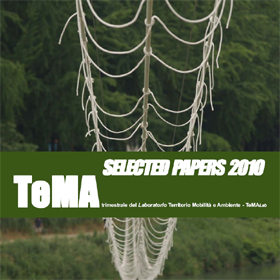 Selected Papers 2010
This special number is a selection of papers published in TeMA 2010 volume and is the second item completely in English. The selected papers are works previosly published in Italian and now presented in a different layout collected into a unique item.
Selected Papers 2010
This special number is a selection of papers published in TeMA 2010 volume and is the second item completely in English. The selected papers are works previosly published in Italian and now presented in a different layout collected into a unique item. -
 Small/Large Urban Projects
Vol 3 No 4 (2010)
Small/Large Urban Projects
Vol 3 No 4 (2010)This fourth issue of the year 2010 wants to make the point, with the illustration of projects and case studies on the processes of integration between urban design and then construction of transport infrastructure. In the vast panorama of interventions designed or implemented in recent years in Italy and abroad, we preferred the two main categories that allow an immediate synthesis of approaches, of intervention systems, of design solutions and of unresolved issues that this methodology puts in place: the Large and Small scale projects.
-
 Moving for Leisure
Vol 3 No 3 (2010)Based on the belief that mobility is a necessary condition for the performance of the tourism practice outright and in particular in urban areas, the issue deals with the theme of tourist mobility in urban areas, looking at a some key measures put in place to adapt the transport supply to the demands of temporary users but with a significant impact on the cities economic balance.
Moving for Leisure
Vol 3 No 3 (2010)Based on the belief that mobility is a necessary condition for the performance of the tourism practice outright and in particular in urban areas, the issue deals with the theme of tourist mobility in urban areas, looking at a some key measures put in place to adapt the transport supply to the demands of temporary users but with a significant impact on the cities economic balance. -
 City Logistics
Vol 3 No 2 (2010)The item deals with the city logistics: that sector of logistics that study and implement solutions for the optimization of freight transport in urban areas. At a time when urbanization is at levels never before reached, the city logistics is a very topical issue for both freight activities essential to the survival of people, and for the quality of life, since the transport in general and in particular goods transport is among the main causes of environmental pollution.
City Logistics
Vol 3 No 2 (2010)The item deals with the city logistics: that sector of logistics that study and implement solutions for the optimization of freight transport in urban areas. At a time when urbanization is at levels never before reached, the city logistics is a very topical issue for both freight activities essential to the survival of people, and for the quality of life, since the transport in general and in particular goods transport is among the main causes of environmental pollution.
-
 Urban Planning and Mobility
Vol 3 No 1 (2010)Urban Planning and Mobility offers a study on the land use-transport integrated planning. This form of coordination must be aimed at achieving a balance between land use policies as input for the planning of transport systems, with the hypothesis that the transport system is a determinant for the evolution of the territorial system.
Urban Planning and Mobility
Vol 3 No 1 (2010)Urban Planning and Mobility offers a study on the land use-transport integrated planning. This form of coordination must be aimed at achieving a balance between land use policies as input for the planning of transport systems, with the hypothesis that the transport system is a determinant for the evolution of the territorial system. -
 Selected papers 2009
Vol 2 (2009)This special number is a selection of papers published in TeMA 2009 volume and is the first item completely in English. The selected papers are works previosly published in Italian and now presented in adifferent layout collected into a unique item.
Selected papers 2009
Vol 2 (2009)This special number is a selection of papers published in TeMA 2009 volume and is the first item completely in English. The selected papers are works previosly published in Italian and now presented in adifferent layout collected into a unique item. -
 Metropolitain Flows
Vol 2 No 4 (2009)This number proposes a study on the mobility system at the supra-municipal scale and in particular on the relationship between the urban sprawl processes and the role of the network and mobility systems. The expansion city changes the organization of space and land use systems, especially residential, environmental, production, equipment and public services, not least the mobility system, which innervates the territories and characterizes its efficiency, to the point that, in many cases, the infrastructural delays come to influence the organization and competitiveness.
Metropolitain Flows
Vol 2 No 4 (2009)This number proposes a study on the mobility system at the supra-municipal scale and in particular on the relationship between the urban sprawl processes and the role of the network and mobility systems. The expansion city changes the organization of space and land use systems, especially residential, environmental, production, equipment and public services, not least the mobility system, which innervates the territories and characterizes its efficiency, to the point that, in many cases, the infrastructural delays come to influence the organization and competitiveness. -
 City and the sea
Vol 2 No 3 (2009)This issue proposes a deepening on the relationship between the city and the sea. The main idea is to consider the urban waterfront and port nodes as border areas and at the same time as links between metropolitan areas and the sea. The urban sea front and harbor areas, projected onto the sea and part of the territory where they are located, are "sensitive areas" in both physical and functional planning and management.
City and the sea
Vol 2 No 3 (2009)This issue proposes a deepening on the relationship between the city and the sea. The main idea is to consider the urban waterfront and port nodes as border areas and at the same time as links between metropolitan areas and the sea. The urban sea front and harbor areas, projected onto the sea and part of the territory where they are located, are "sensitive areas" in both physical and functional planning and management. -
 Security and Mobility
Vol 2 No 2 (2009)This issue provides a number of investigations on security applied to transport systems, which, as tools of strategic importance to the daily life of communities, are matters exposed at high vulnerability in connection with its use and with respect the occurrence of catastrophic events. The number face to the different aspects of the security issue applied to people and goods transport systems for different transport modes and with different approaches.
Security and Mobility
Vol 2 No 2 (2009)This issue provides a number of investigations on security applied to transport systems, which, as tools of strategic importance to the daily life of communities, are matters exposed at high vulnerability in connection with its use and with respect the occurrence of catastrophic events. The number face to the different aspects of the security issue applied to people and goods transport systems for different transport modes and with different approaches. -
 Parking Policies and the City
Vol 2 No 1 (2009)The number provides an insight into the role of the parking government for sustainable mobility in urban areas, illustrating methods, strategies, tools and interventions to be implemented through the study of recent literature and analysis ofnational and international best practices.
Parking Policies and the City
Vol 2 No 1 (2009)The number provides an insight into the role of the parking government for sustainable mobility in urban areas, illustrating methods, strategies, tools and interventions to be implemented through the study of recent literature and analysis ofnational and international best practices. -
 Soft Mobility
Vol 1 No 3 (2008)The iussue is focused on Soft Mobility at the urban and regional scale trough theorical reflections and analysis of Italian and European best practices.
Soft Mobility
Vol 1 No 3 (2008)The iussue is focused on Soft Mobility at the urban and regional scale trough theorical reflections and analysis of Italian and European best practices. -
 Great events and Mobility
Vol 1 No 2 (2008)The issue deals with the planning and management of transport systems and mobility during major events. Through theoretical considerations and applications, the number analyzes the planning schemes in the field to respond to the need of make accessibilie the area of exposure to large flows of visitors, both to incorporate the new design works in the development of the city.
Great events and Mobility
Vol 1 No 2 (2008)The issue deals with the planning and management of transport systems and mobility during major events. Through theoretical considerations and applications, the number analyzes the planning schemes in the field to respond to the need of make accessibilie the area of exposure to large flows of visitors, both to incorporate the new design works in the development of the city. -
 High Speed Cities
Vol 1 No 1 (2008)This issue of the magazine deals with a topic of great interest to those who want to study the relationships between urban systems and mobility system: the High Speed Cities. The aim is to reflect on the many effects, not yet sufficiently investigated, that the start-up high-speed train may have, from different points of view and at different scales, on spatial and functional organization of urban systems involved.
High Speed Cities
Vol 1 No 1 (2008)This issue of the magazine deals with a topic of great interest to those who want to study the relationships between urban systems and mobility system: the High Speed Cities. The aim is to reflect on the many effects, not yet sufficiently investigated, that the start-up high-speed train may have, from different points of view and at different scales, on spatial and functional organization of urban systems involved. -
 Numero Zero
Vol 1 (2007)
Numero Zero
Vol 1 (2007)With the zero number issue, and the launch of the new magazine is our intention is to give our contribution to building new skills, scientific and professional at the same time, on a topic of increasing interest to those who study and work in the areas of physical transformations of the city and the region: the integration between the disciplines studying urban transformation and those that address the issues of mobility governance. We would say more, perhaps now is the time to ask ourselves a more ambitious goal: to build a new body of theoretical and methodological knowledge which extends beyond the fences that mark the border - quite apparent - between these disciplines, and to be able to formulate new solutions to a problems that we continue to deal with the old tools of the scientific culture of the last century.
TeMA Journal
TeMA. Journal of Land Use, Mobility and Environment offers researches, applications and contributions with a unified approach to planning and mobility and publishes original inter-disciplinary papers on the interaction of transport, land use and environment.
With ANVUR resolution of April 2020, TeMA Journal and the articles published from 2016 are included in A category. TeMA Journal has also received the Sparc Europe Seal for Open Access Journals released by Scholarly Publishing and Academic Resources Coalition (SPARC Europe) and the Directory of Open Access Journals (DOAJ). From 2015, the articles published on TeMA are included in the Core Collection of Web of Science.
Call for paper
TeMA vol. 17 (2024)
TeMA Journal intends to propose articles that deal the effects of global warming, the ageing of population, the reduction of energy consumption from fossil fuels, the immigration flows from disadvantaged regions, the technological innovation and the optimization of land use.
Editor-in-Chief: Rocco Papa | With ANVUR resolution of April 2020, TeMA Journal and the articles published from 2016 are included in A category. | print ISSN 1970-9889 | online ISSN 1970-9870 | © 2008 | Registration: Cancelleria del Tribunale di Napoli, n° 6, 29/01/2008 | TeMA is edited by the Laboratory of Territory, Mobility and Environmental of the University of Naples Federico II | Journal realized with Open Journal System and published by FeDOA - Federico II University Press at Center for Libraries "Roberto Pettorino" | TeMA is indexed in ANCE Catalogue of CINECA MIUR code n. E193096 and in DOAJ Directory of Open Access Journals. From 2015, the articles published on TeMA are included in the Core Collection of Web of Science.
